Spaghetti all’assassina has gone from being a recipe loved by the people of Bari to one of the most Googled and Instagrammed dishes in Italy.
A specialty of Bari, our regional capital, spaghetti all’assassina is a pasta dish cooked using a rather unconventional method. Possibly one of the reasons why you will be hard pressed to find it on the menu outside Italy – and lucky to find it beyond Bari. Another reason why no vacation in Puglia is complete without a visit to Barivecchia for a plate of Bari’s best.
Follow us on Instagram for frequent video stories, reels, photos, ideas and other information to inspire your stay in Puglia.
Spaghetti all’Assassina | the Podcast
In this guide
What is spaghetti all’assassina?
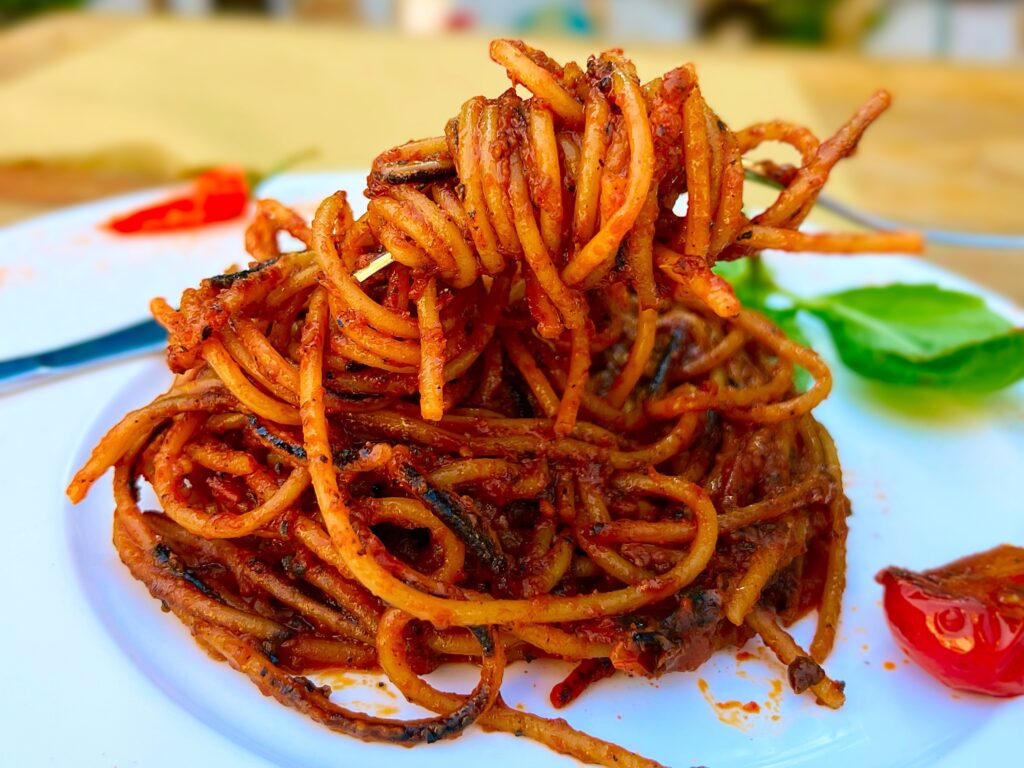
Spaghetti all’assassina is a fiery pasta dish from Bari, known for its bold flavour and dramatic cooking method. Unlike most pasta dishes, the spaghetti is not boiled in water but cooked directly in a pan with tomato passata, garlic, olive oil, and a generous amount of chilli, creating a charred, caramelised texture. The result is a dish that’s crispy at the edges, smoky, spicy, and deeply savoury.
Despite its ominous name, spaghetti all’assassina—literally “Assassin’s Spaghetti”—isn’t a relic from Puglia’s distant past. The origins of assassina date back to the late 1960s, at Bari’s Al Sorso Preferito restaurant, where chef Enzo Francavilla is said to have improvised the dish when diners requested something hot and unconventional. So intense was the heat of the chilli, the story goes, that a guest jokingly accused the chef of trying to kill them—hence the name.
Though it experienced periods of obscurity, the dish has made a strong comeback in recent years. The founding of the Accademia dell’Assassina in 2013 played a major role in its revival, preserving and promoting the traditional method. It’s also gained wider fame thanks to appearances in Italian media, including the TV series Le indagini di Lolita Lobosco. In 2024, spaghetti all’assassina became one of Italy’s top ten most searched recipes—testament to its growing cult status.
There’s still debate over what defines the “authentic” version of the recipe. In Bari’s kitchens, you’ll find variations in approach, but purists agree on one thing: technique is everything. According to the official version endorsed by the Accademia, the dish must be cooked in a heavy black cast-iron frying pan, known locally as a sartàscene. The spaghetti is fried raw in olive oil, then cooked risottata—like risotto—with ladles of spiced tomato broth added gradually. The goal? To achieve spaghetti bruciati (burnt spaghetti), a crunchy, slightly burnt crust with just the right amount of char—never bitter, always bold.
These days, many variations of the recipe exist, with the addition of a variety of other ingredients: stracciatella, cime di rape, raw tuna, smoked pepper sauce, canestrato cheese sauce… “There’s been an excessive use with pointless and unnecessary variations,” notes gastronomist Sandro Romano.
We agree. On our last visit to Urban L’Assassineria Urbana there were 14 different versions of the dish on the menu. Assassina should be crispy, slightly charred, and spicy. But as more ingredients and flavours are added, the further away you get in terms of taste and texture from an authentic assassina.
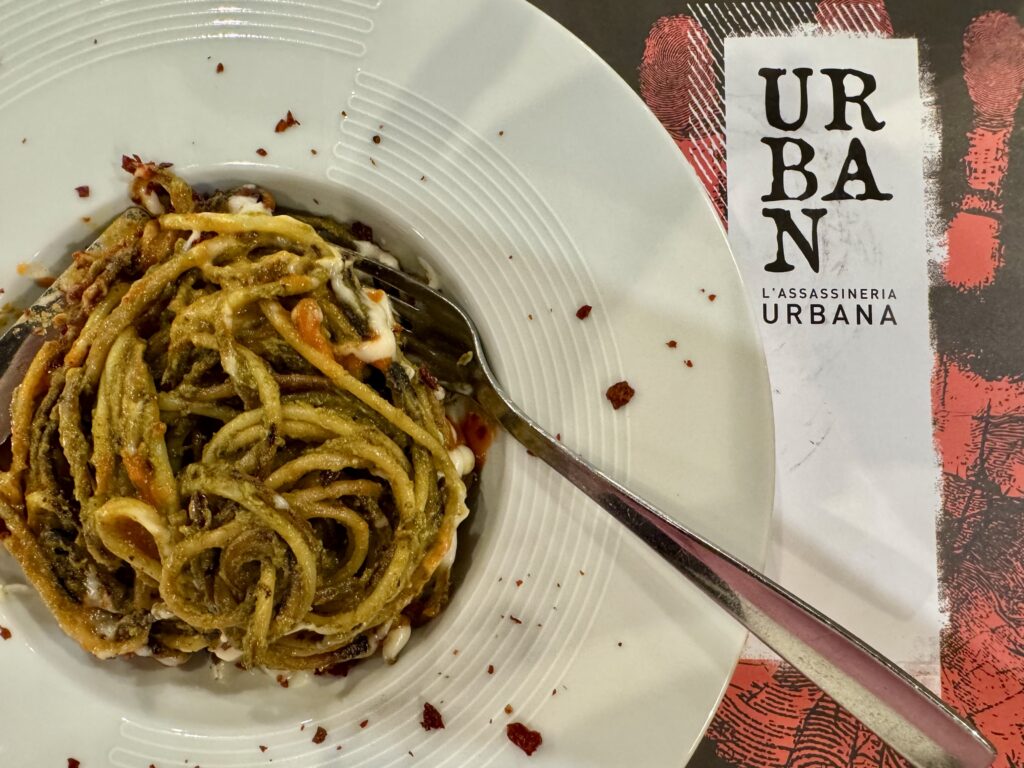
A taste of Mediterranean noir
Renewed domestic interest in the dish is in part thanks to two well-known Italian writers of the ‘Mediterranean noir’ genre. Well suited to the role as the name suggests, spaghetti all’assassina becomes an integral part in the plot of novels by brothers Gianrico and Francesco Carofiglio, and by Gabriella Genisi.
Both novels include the recipes (along with others from the Bari table that feature in the narrative) as appendices.
The Carofiglio brothers were the first to mention assassina in a literary work in their 2014 book La casa nel bosco (“The House in the Woods”), described as “an evolution of leftover and slightly charred pasta made during times when nothing was wasted.”
Lolita Lobosco
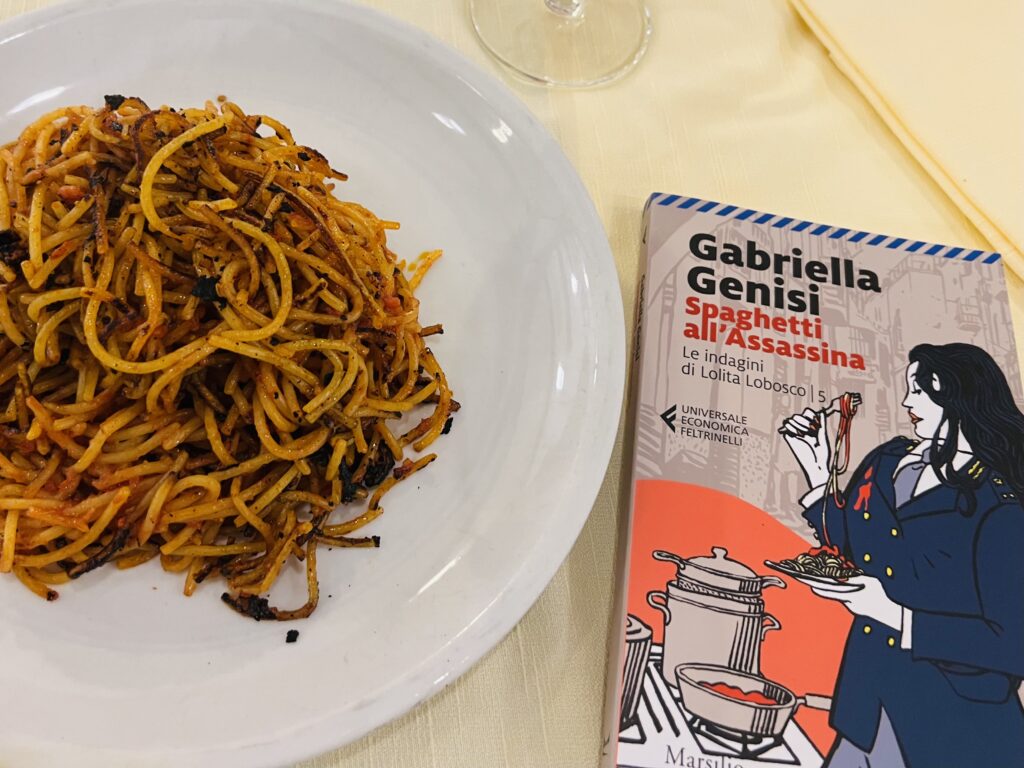
Gabriella Genisi’s 2015 novel Spaghetti all’Assassina tells the story of the murder of a chef known for being among the best at preparing them. Genisi’s protagonist Lolita Lobosco, a deputy police commissioner from Bari, is described as a beautiful, sensual thirty-six year old, bold and “good in the kitchen”.
The derivative 2021 RAI hit television series Le indagini di Lolita Lobosco brought the dish into Italian homes, further popularising the recipe.
TV times
TV cooking shows have also raised the profile of assassina. In 2018, Bari chef Almo Bibolotti wowed the judges of the Italian MasterChef series when he prepared the dish, leading one of them to exclaim that the dish was “out of this world”.
The same view was recently echoed by American actor and food writer Stanley Tucci in his TV series Searching for Italy.
“This goes against everything I know about pasta,” he remarked, effusive in his praise for the dish. “Honestly, I’ve never seen anything like that before… And I’ve been around, too!”
Spaghetti all’assassina | a dish of two halves
In recent years, spaghetti all’assassina has become a kind of status symbol among Bari’s restaurants—a badge of honour worn proudly and judged by the boldness, burn and brilliance of each plate served.
But even its success is not without debate. Two restaurants claim credit for its invention: Al Sorso Preferito and the now defunct Marc’Aurelio. Two dominant schools of thought claim to trace its path from kitchen curiosity to culinary icon, each with differing timelines and origin stories. As if that weren’t enough, there are also two rival “academies”, each self-appointed guardians of the dish’s authenticity and heritage.
Even the meaning behind the name assassina is contested—some say it refers to the dish’s fiery heat, others to “killing” the spaghetti. And then there’s the cooking itself: should the pasta be scorched from raw or semi-boiled first? As ever with legends, there is more than one version of the truth.
How has this come about?
Rise, like a phoenix | spaghetti all’assassina on the menu
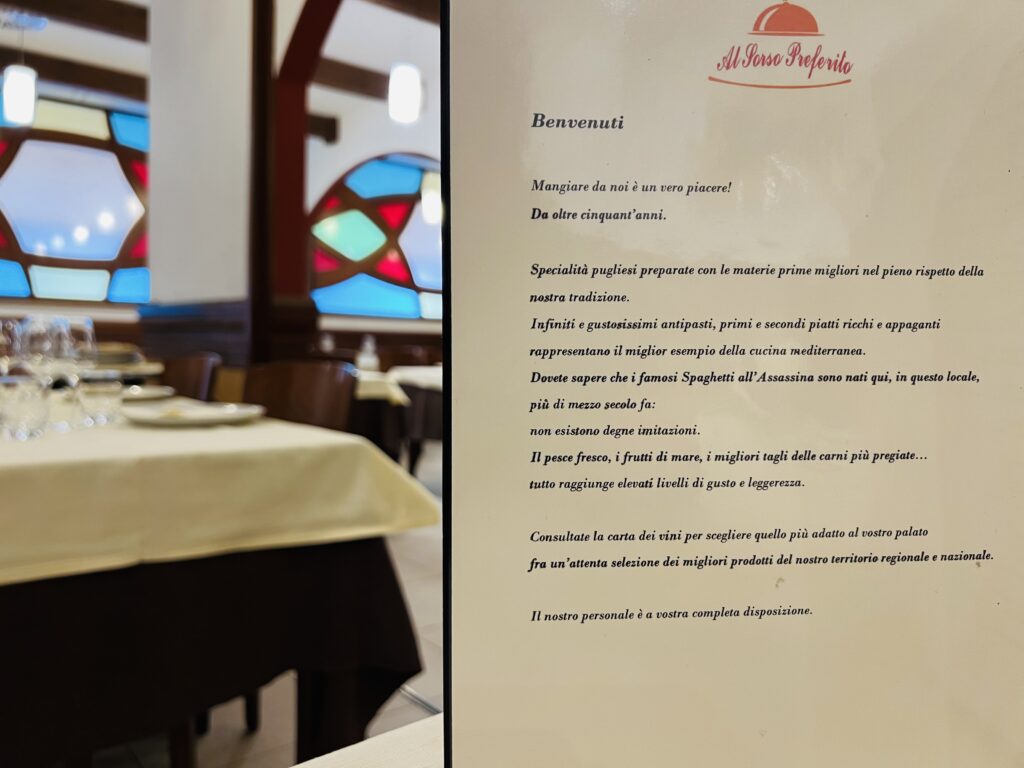
there are no worthy imitations”.
The first appearance of spaghetti all’assassina likely dates back to the late 1960s or early ’70s. Despite a strong debut, the dish faded into relative obscurity for decades. It was rarely seen on menus in Bari, deemed too recent to be “traditional” for old-school trattorie, and too rustic for the polished plates of 1980s nouvelle cuisine. Somewhere in between, it simply disappeared.
Fast forward to today, and spaghetti all’assassina is enjoying a red-hot revival. A cult favourite among locals and tourists alike, it’s now the subject of enthusiastic detective work, with fans hungry for every spicy detail of its origin story.
The recipe itself was never formally recorded. Instead, it spread through whispers in kitchens—part improvisation, part necessity, part clever resourcefulness. Like many iconic dishes, its history is laced with intrigue: rumours, red herrings, and a healthy dose of speculation. The truth, much like the dish itself, is somewhere in the char.
But thanks to the reporting of gastronomist and journalist Sandro Romano and the researches of local Bari historian Felice Giovine—based on a review of archive documents and personal interviews with Enzo Francavilla—a definitive version of events is emerging.
The scorched legend of spaghetti all’assassina
In 1967 Enzo Francavilla, an ambitious chef from Foggia in Puglia, bought over the business of Al Sorso Preferito a small family run trattoria in Bari. Just days after opening he was approached by two Neapolitan diners requesting something spicy and hearty. Thinking on his feet, Francavilla seared dry spaghetti in an iron pan with oil, garlic, chilli, and tomato sauce—cooking it risotto-style and letting it char deliberately. The resulting dish was rich, spicy, and crispy in parts, unlike any pasta the diners had encountered before.
The verdict? “Delicious,” they said. But one, tongue tingling, added with a grin: “You’re a murderer.” And with that, the name spaghetti all’assassina—“killer spaghetti”—was born.
From that moment, the dish became a local sensation. In 1972, Francavilla moved the restaurant to Via de Nicolò, naming it Osteria La Marianna al Sorso Preferito in memory of his late wife. Lines formed nightly for one of just two house specialities: orecchiette mantecate and the now-legendary assassin’s spaghetti.
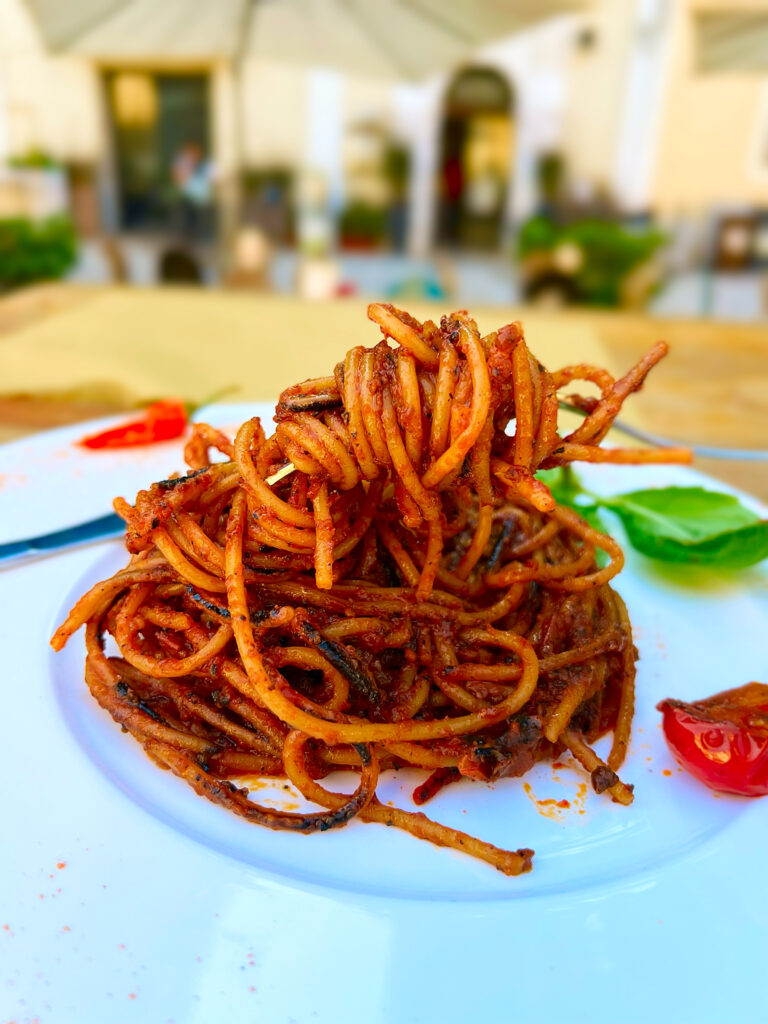
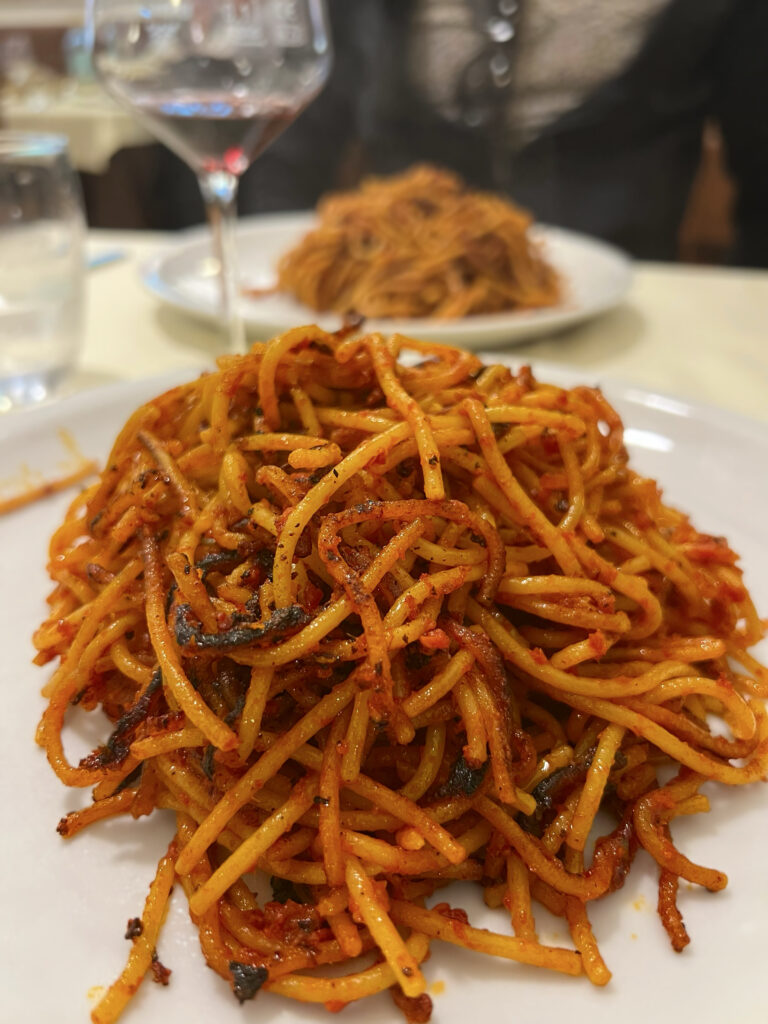
Nicholas Antonacci, a Bari-based maître-sommelier and chef by trade who in 1981, at just sixteen years old, was promoted to demi chef at Il Sorso Preferito, offers a slightly different version. He recounts how an angry spaghetti all’arrabbiata slowly evolved into a killer spaghetti all’assassina.
Initially serving chilled meats and cheeses, Antonacci explains how chef and owner Enzo Francavilla gradually introduced hot dishes in response to popular demand, including a fiery spaghetti all’arrabbiata. With time, the well-used iron pans used to cook the arrabbiata sauce began to yield a charred, caramelised crust adding new depth to the dish. Diners drank more wine, laughed harder, and, so the story goes, one declared: “This is a killer!”—and spaghetti all’assassina was born.
By the late 1970s, the restaurant passed into new hands: maître d’s Giuseppe Saracino and Mimì De Cosmo, alongside chef Gaetano “Nanuccio” Lonigro. The trio would go on to acquire another of the city’s landmark restaurants, Marc’Aurelio, later bringing in Pierino Lonigro—Nanuccio’s brother and a skilled chef in his own right. It was during this period spaghetti all’assassina made the leap from off-menu curiosity to a fully fledged first course.
Antonacci notes that many chefs who passed through Il Sorso Preferito and its sister restaurant Marc’Aurelio took fragments of the assassina story with them—recipes adapted, origins forgotten, and in some cases, credit claimed.
Today, Il Sorso Preferito remains in the ownership of Pierino Lonigro who, with his nephew Vincenzo in the kitchen, is still serving up the dish.
Some consider the origins of the recipe to be more distant. This is either a recycled dish made from leftover pasta cooked the day before, or the clever invention of Bari housewives diluting the tomato sauce to make it go a little further and transforming it into a surprising spaghetti for unexpected guests. There is, after all, a well known saying in Bari dialect: “Addò màngene do, màngene tre” (where two people can eat, so can in three).
Francavilla may have been inspired by that leftover pasta that was “fried” on Sunday evenings in the homes of Bari. Or even perhaps by the tasty crust of baked leftover pasta. But leftover pasta in Bari was made using rigatoni or orecchiette from Sunday lunch, with its ragù. Never with spaghetti.
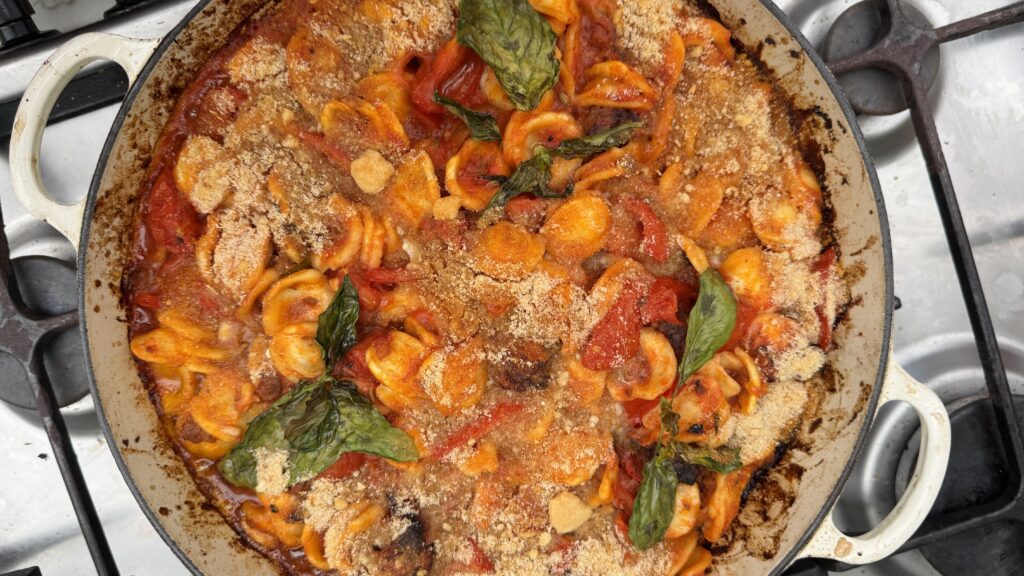
On this, both academies are at one and do not compromise. Spaghetti all’assasina is not a recycling solution for leftover spaghetti and tomato sauce. The spaghetti must be cooked from raw, using the required ingredients and according to the specified if not unconventional risottata method. Which includes that black iron frying pan from Bari Vecchia!
Spaghetti all’assassina Academies
The (original) Accademia dell’Assassina was founded by experts and enthusiasts in 2013. Their meetings were reserved exclusively and strictly for men only. This initiated a women only ‘Contraccademia’. The job of both continues to be to meet, taste and opine on the assassina dishes offered across Bari. Relations have thawed to the extent that ‘plenary’ meetings now take place where tastings are shared.
The academies have a social purpose, but more importantly in their view, have a role to prevent the diffusion of the dish. Which serves up another dichotomy. Cooking respects tradition. But one of its best traditions is innovation and evolution in the kitchen. Our eating out experience has rewarded us with some amazing versions of assassina that go beyond the rules of the Accademie.
There is also an International Assassina Academy. Based in Bari, the worldwide spaghetti all’assassina ambassadors were established to promote Puglia’s signature dish and curate spaghetti all’assassina recipes as its popularity spreads around the world.
Killer spaghetti or spaghetti killer?
The name of this dish comes from the cooking method—where the spaghetti is sautéed in the pan from raw, effectively “murdered” until it’s charred, and crisp.
When Stanley Tucci visited Bari, he was told by the chef that cooked it for him that the dish was named spaghetti all’assassina – killer’s spaghetti – because the diner it was originally cooked for found its chilli heat so fierce he choked on it and accused the chef of trying to kill him with its fiery ferrocity.
The former was confirmed to us when we spoke to chef Pierino (Pietro) Lonigro, credited at Al Sorso Preferito as the ‘inventor’ of spaghetti all’assassina (an early pioneer of the dish who took learned the recipe from Enzo Francavilla and took over the kitchen after him, Pierino is credited with introducing assassina to the restaurant menu—the first so to do). The cook “kills” the spaghetti treating it cruelly in the pan, the spaghetti screams and hisses as it “burns” to death. Tough love! This was also the version explained to us when we spoke to a Bari historian and academic over lunch recently.
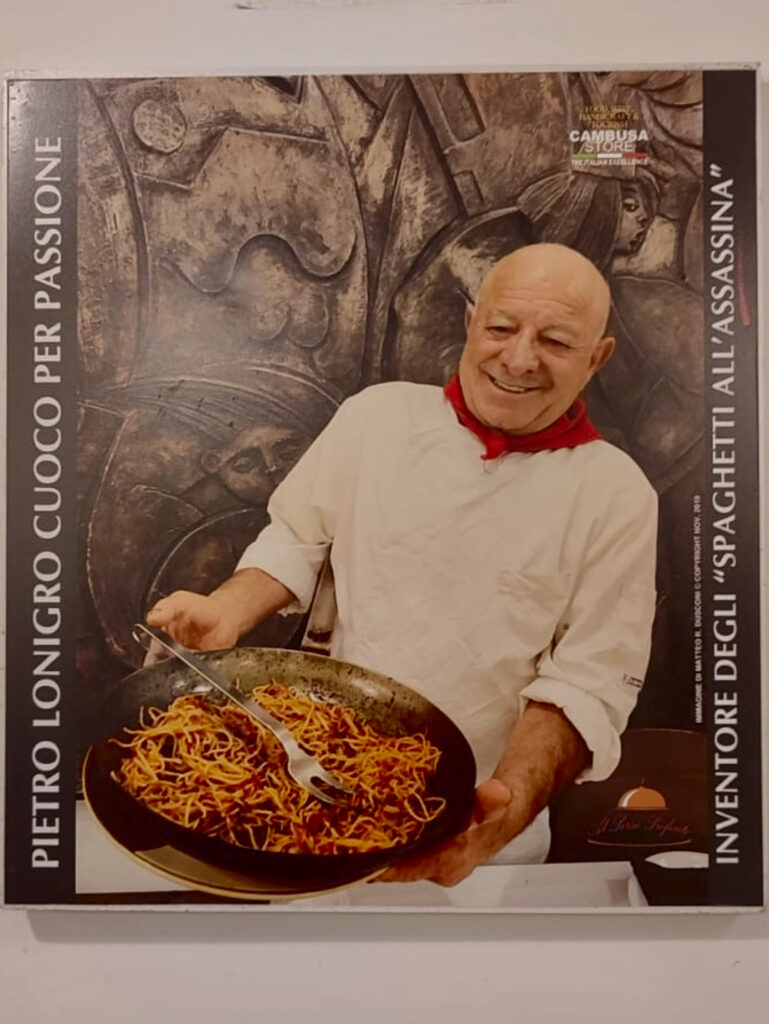
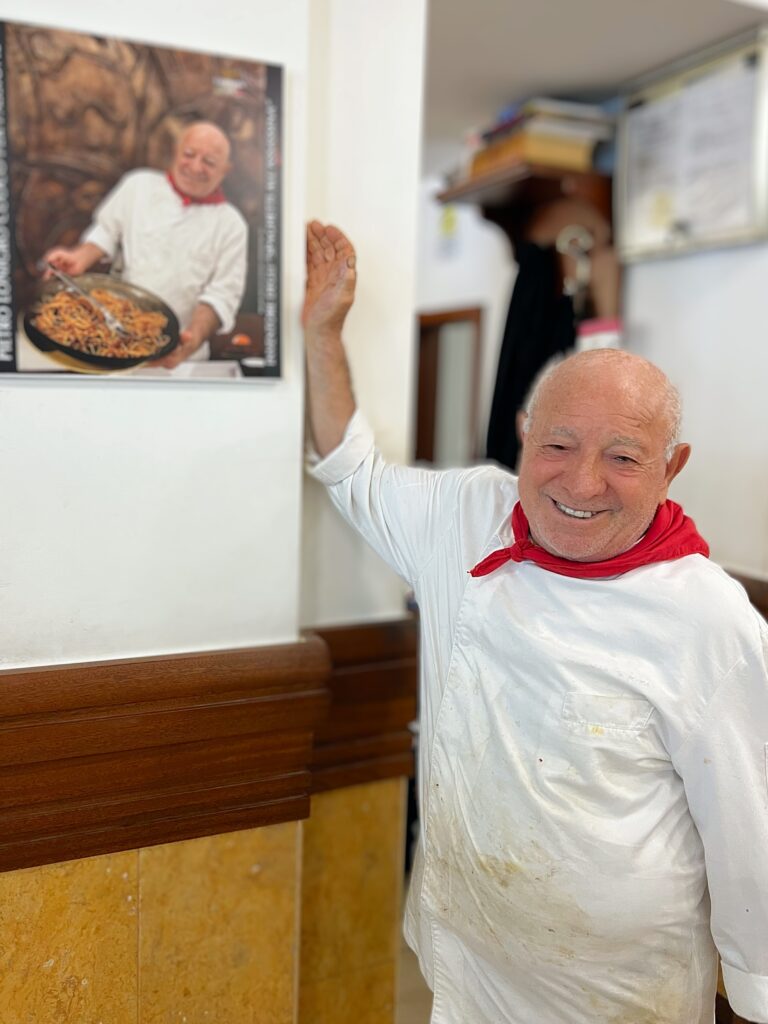
In reality you will be hard pressed to find an assassina dish in Bari that has such a ferocious heat. Piccante is relative. In Puglia chilli is not used for fiery hot heat. It’s a subtle warmer of traditional dishes. Locals do not typically enjoy a fiery heat. Not really because of a fear of the heat, but rather because the taste of food is important and a fierce chilli heat would overpower any dish and the important balance of flavours.
But for those accustomed to another cuisine’s use of chilli, spaghetti all’assassina comes out on the comforting warmth end of the spectrum. Another reason why it is unlikely the name of the dish has to do with a choking chilli heat!
Assassina | the risottatura “error”
I burnt the garlic in an iron pan with oil and chilli—not just browned, but burnt—and then removed it.
Into the boiling oil, I poured raw, hand-crushed peeled tomatoes, causing a flare-up. That flare-up was the ‘joy of the kitchen,’ which I immediately covered with a lid. The resulting smoke remained inside, imparting a smoky flavour to the spaghetti, as if they were burnt, but they were actually roasted.
Meanwhile, I brought water and salt to the boil and cooked the spaghetti—actually vermicelli—until just before al dente, when they began to bend. I drained them well and added them to the pan with the tomato to absorb the flavours. I stirred continuously, adding more raw, crushed tomatoes if they became too dry, and continued cooking until the pasta was done and the tomato had thickened. I tasted them to check the cooking, flavour, and salt, then gave them a superficial toasting. I finished by adding a little oil to give them a sheen, and my recipe was complete.
From Sandro Romano’s interview with Enzo Francavilla.
According to this account there is no ‘risottatura’ (cooking pasta like risotto) or toasting of the pasta—techniques considered essential by the Accademia dell’Assassina.
In practice, few restaurants perform the ‘risottatura’. When we interviewed him, Pierino Lonigro of Al Soso Preferito confirmed that the spaghetti is pre-cooked for convenience and speed of service. Yet at Urban Assassineria, it is essential that the spaghetti is toasted.
Mission assassina | on the assassin’s trail
Which leaves us with only one last job, before we leave you with the recipes. To give you our recommendations on where to go in Bari to eat the bast spaghetti all’assassina.
Fortunately we have our own well plotted assassin’s trail. These are restaurants that we have eaten at or are still on our waiting list, the favorite spots and regular haunts of friends from Bari.
We don’t accept any payment or freebies for coverage or in return for recommendations. Our reviews are anonymous to ensure we get the same experience as any visitor.
Ai 2 Ghiottoni
Via Nicolò Putignani 11, tel 080 523 2240 | website.
Al Sorso Preferito
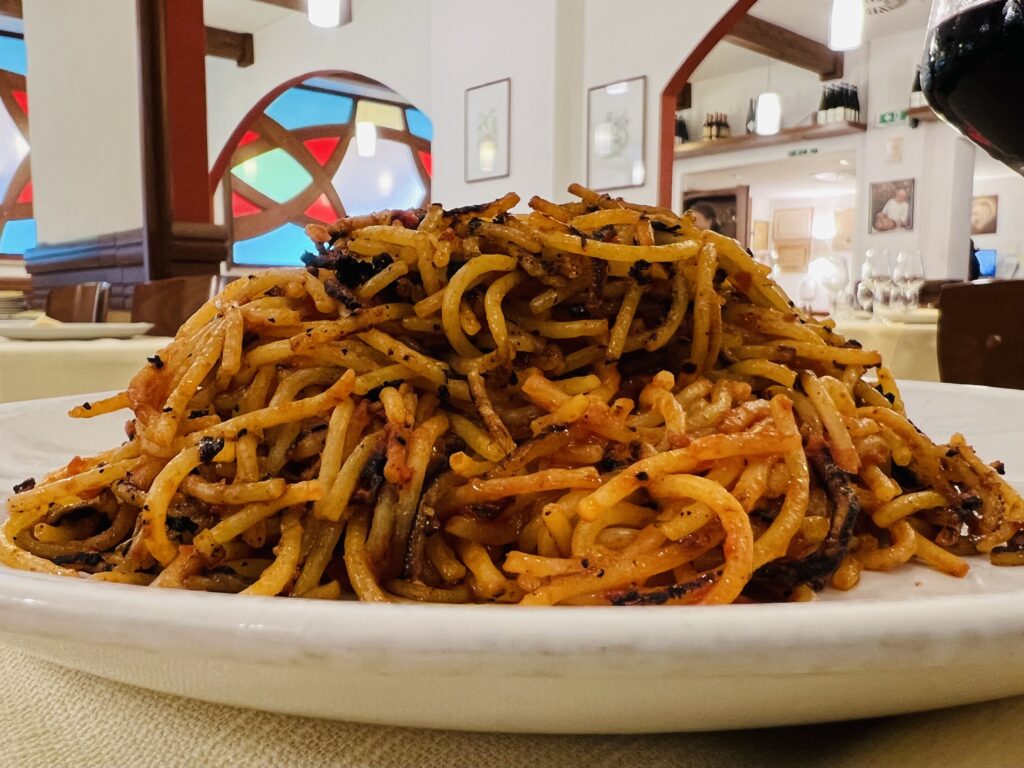
Let’s start at the very beginning, a very good place to start. No homage to Bari’s spaghetti all’assassina would be complete without eating the dish at ‘source’. Served piping hot and wafting a glorious burnt scent, we almost cried. 11€ for a very generous plate, a 2,50€ cover (included bread and potato chips) and 3€ for a glass of house negroamaro. Via Vito Nicola De Nicolò 40, tel 0805 235747 | website.
Buenallegre
Located in the beating heart of Bari Vecchia along an artery off Piazza Mercantile. Cooked strictly in adherence, the spaghetti are mixed no more than twice to ensure burnt crispness, and served with a basil leaf. Two other versions of spaghetti all’assassina are on the menu, one with tuna, and the other with stracciatella cheese. Via Re Manfredi 6, tel 080 576 0033 / 333 913 5300 | website.
Chez Jo
The spaghetti is boiled for a few minutes, before being killed-off in the frying pan. Via Einaudi 69, tel 080 548 4836 | Facebook.
Le 2 Aquile
Via Salvatore Cognetti 53, tel 080 202 2483 | website.
Ghiotto Panzerotto
For nonna’s home cooking, serving up a no frills spaghetti all’assassina. They also have the original Assassina di Rape. Via Pio XII 43, tel 080 202 1568 | website.
Giampà
Accademia dell’Assassina approved, enjoy the classic assassina or try to the version with cardoncelli, Parmesan and datterino tomato fondue. But the killer here might just be the assassina al mare, with seafood. Via Antonio Lucarelli 82, tel. 0805 668097 | website.
Pizzeria & Spaghetti House Bari-Napoli
Via Niccolò Piccinni 187/189, tel 080 990 5452 | website.
Il Quadrifoglio
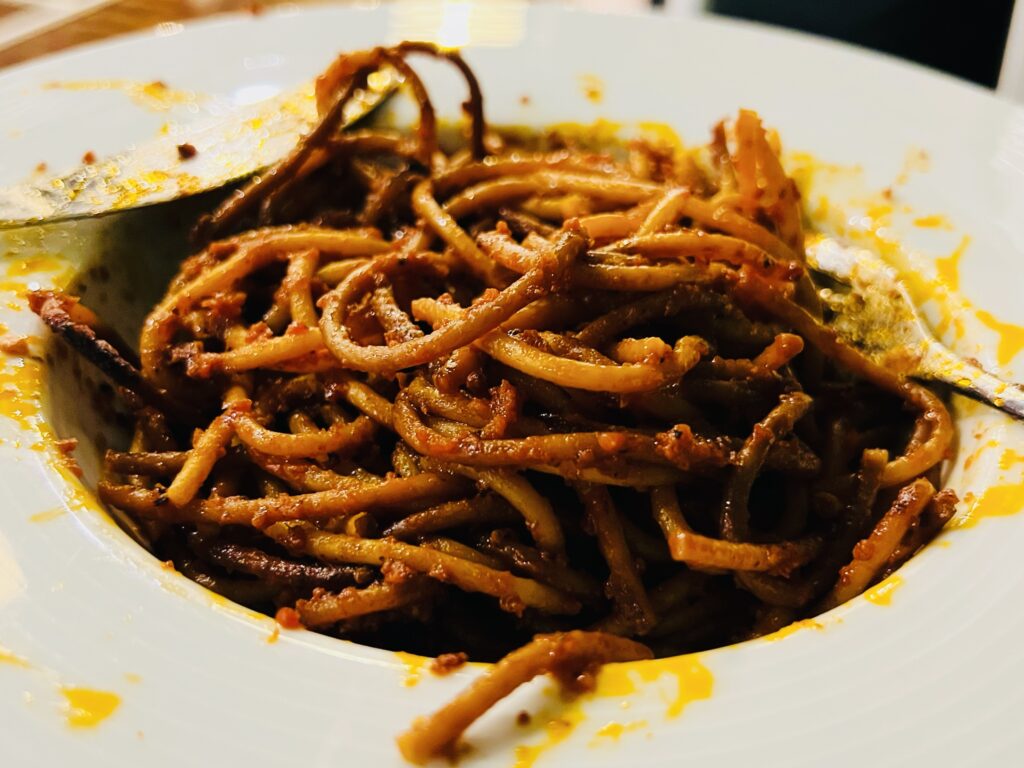
Another pizza restaurant well known for its excellent spicy spaghetti all’assassina. Via Generale Carlo Alberto dalla Chiesa 2, tel 080 502 5561, 389 207 8422 | Facebook.
La Locanda dell’Elfo
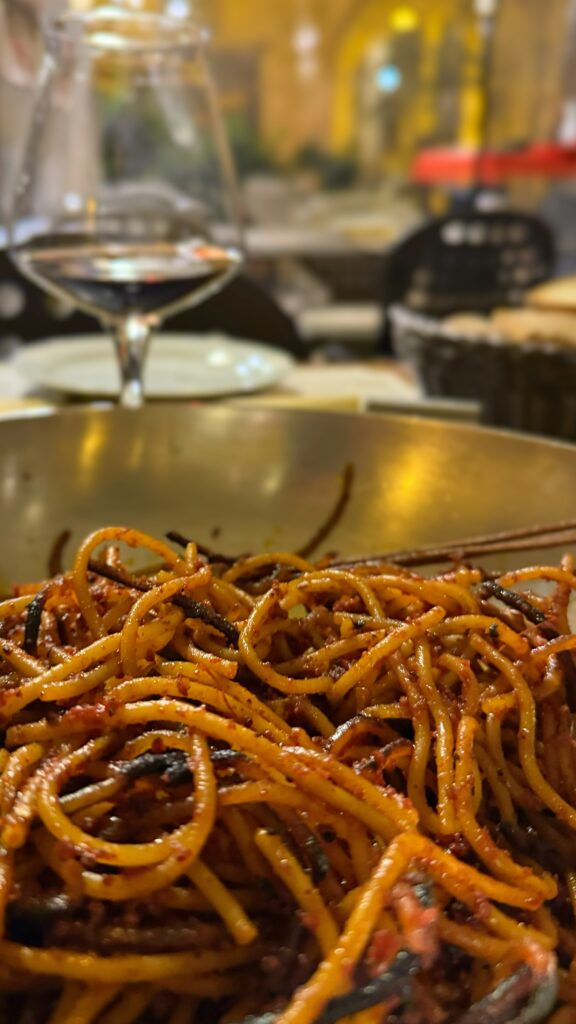
Spaghetti all’assassina wasn’t on the menu in this local restaurant in Barivecchia – you just had to know to ask for it. And while we were eating ours quite a few more local barese did exactly that. If you know, you know. Delicious – and just as it should be: burnt, crispy and fiery. Literally, in this case.
Strada dei Gesuiti, 28/30, tel 329 325 7911 / 371 664 9485 | website.
La Rucola
Via Ottavio Tupputi 10, tel 080 548 6289 | Facebook.
Il Sifà
Via Giuseppe Bottalico 34, tel 080 975 5019 | Facebook.
Superpizza
Don’t be put off by the name. Pizza may be the main focus, but the assassina is served up fiery and robust, in generous proportions. Via Nicola Angelina 12, tel 393 9707309 | Facebook.
Tabula Rasa
After being featured on Italian TV chef Alessandro Borghese’s Quattro Restaurants, Tabula Rasa’s assassina is high up on the list of many Baresità. Made with fresh severely scorched cherry tomatoes. Via Orfeo Mazzitelli 268, tel 329 304 0917 | website.
U’Kor
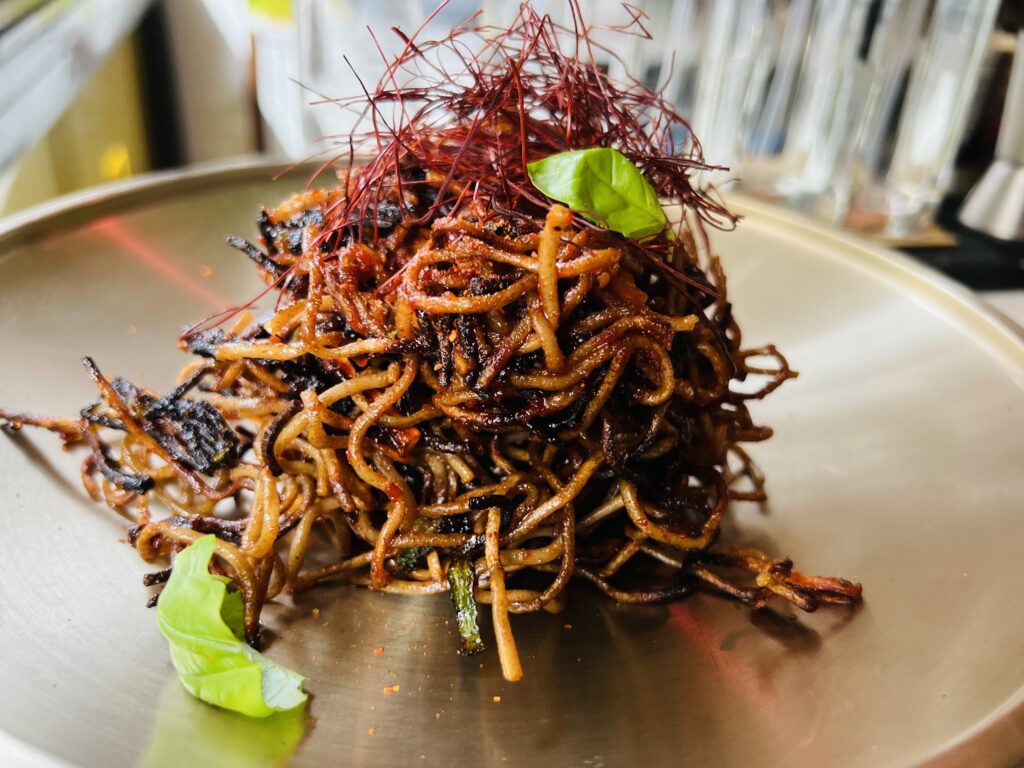
The new kid on the block. We predict this will quickly become the must eat 2023 destination on Bari’s increasingly trendy assassina trail. Unlikely to become Accademia approved, this assassina was made with thinner rice noodle, vegetables, some Korean spices and chilli paste. But it blew us away with crisp, crunchiness perfectly suited to this dish, a classic fusion and innovation of crossover cuisine. And the fragrant basil leaf lifted it beyond wonderful!
We had kimchi focaccia baresi (another amazing fusion), assassina, 2 glasses of bio wine, coffee and 2 digestivi (one was an amazing Korean digestivo), all for 25€. Via Roberto da Bari 130, tel 080 918 8664 | website.
Urban L’Assassineria Urbana
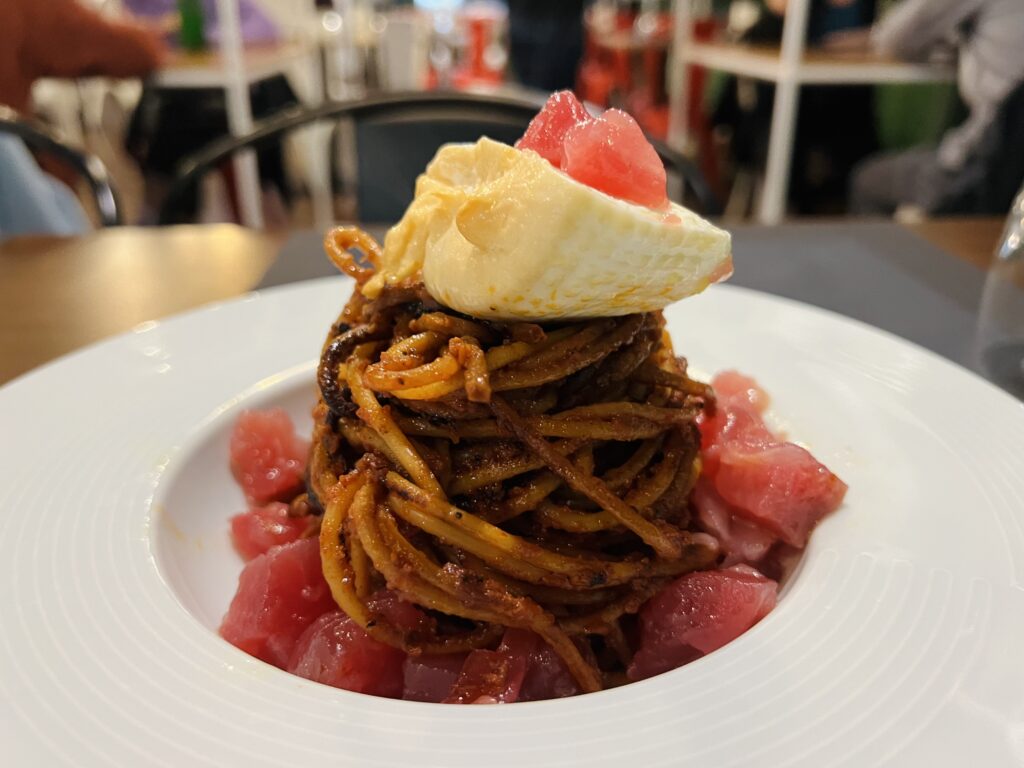
Located in the hipper University quarter in downtown Bari, the restaurant focuses on spaghetti all’assassina. This is the restaurant Stanley Tucci visited for his Discovering Italy tv series.
On our first visit there were nine different versions with two “specials” changing monthly. On our last there were 14. Having tried a variety of assassine dishes there, we realise that as more ingredients and flavours are added, the further away you get in terms of taste and texture from assassina.
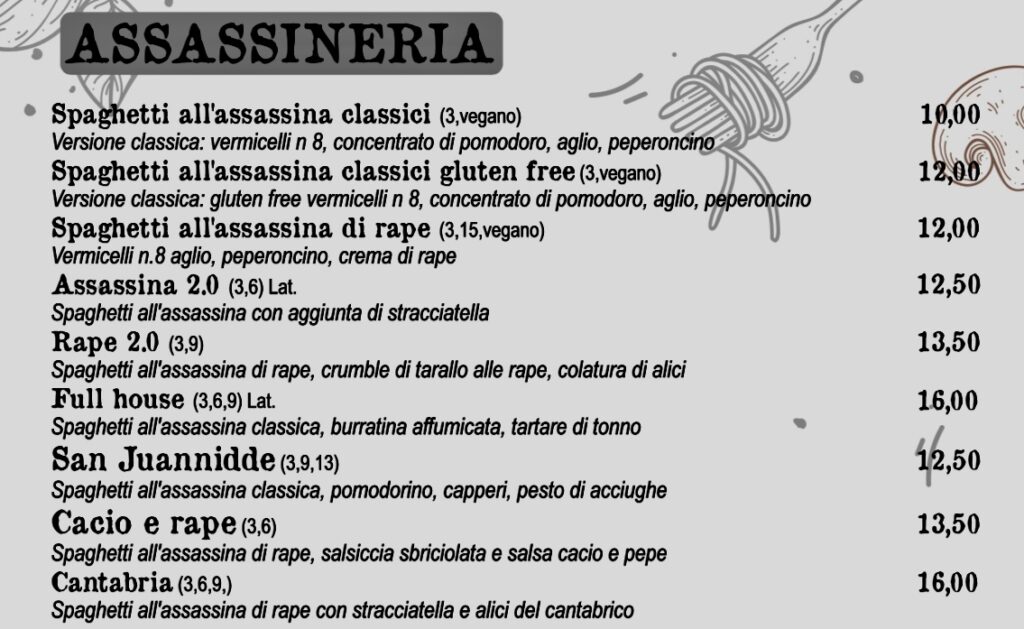
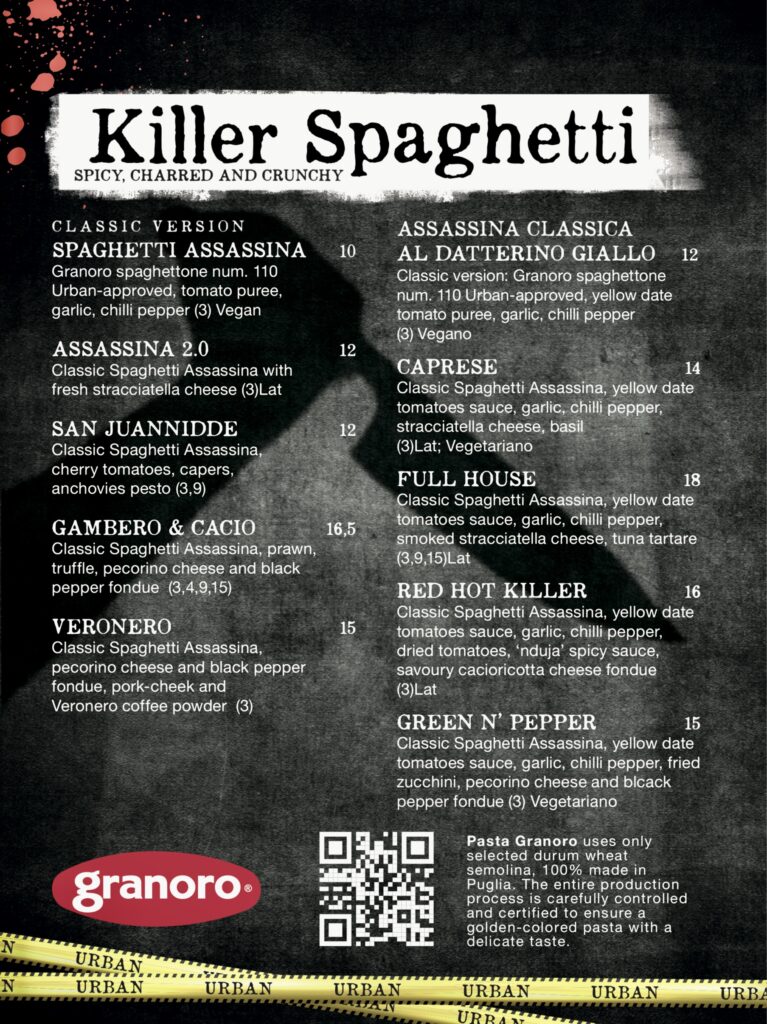
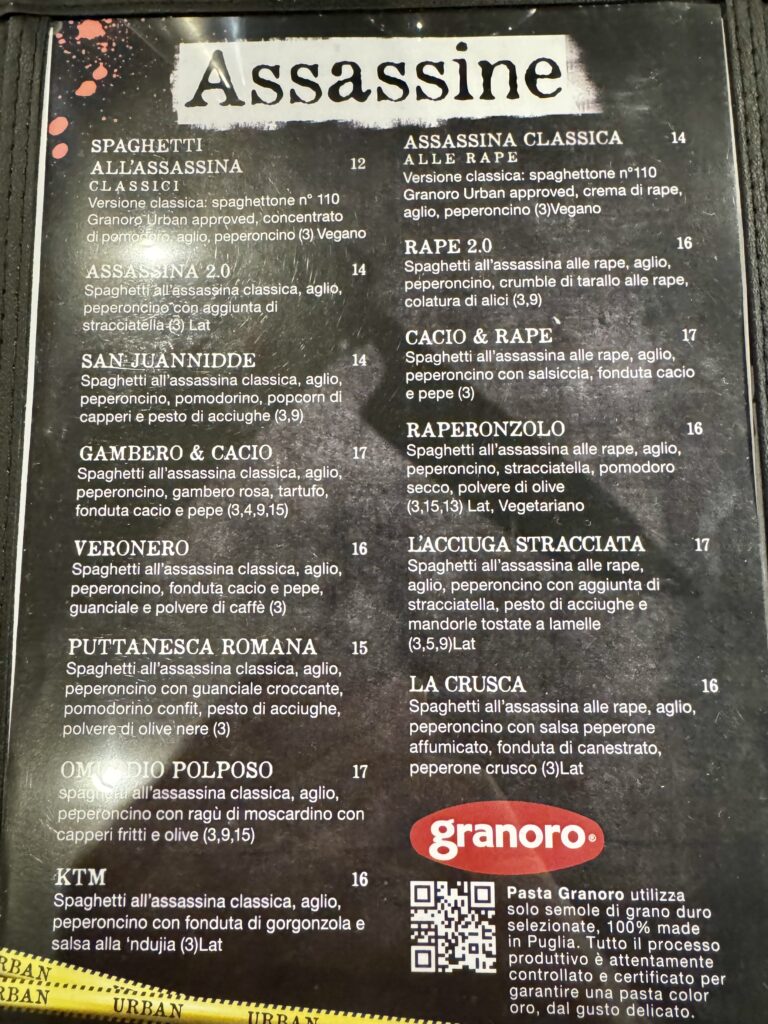
The key to spaghetti all’assassina is that the spaghetti should be crispy, slightly charred, and spicy. The rich tomato flavour is absorbed by the spaghetti, which ends up partly soft and partly crunchy—like the crust of a baked pasta dish.
On our last visit we tried the ’Crusco’, spaghetti all’assassina with a cime di rapa type pesto, with a smoked pepper sauce and a canestrato cheese sauce. We wished that we hadn’t. This wasn’t assassina, simply a spaghetti pesto dish with a confusion of too many flavours. Gone was the smoky char and the spaghetti was more soft than crunchy.
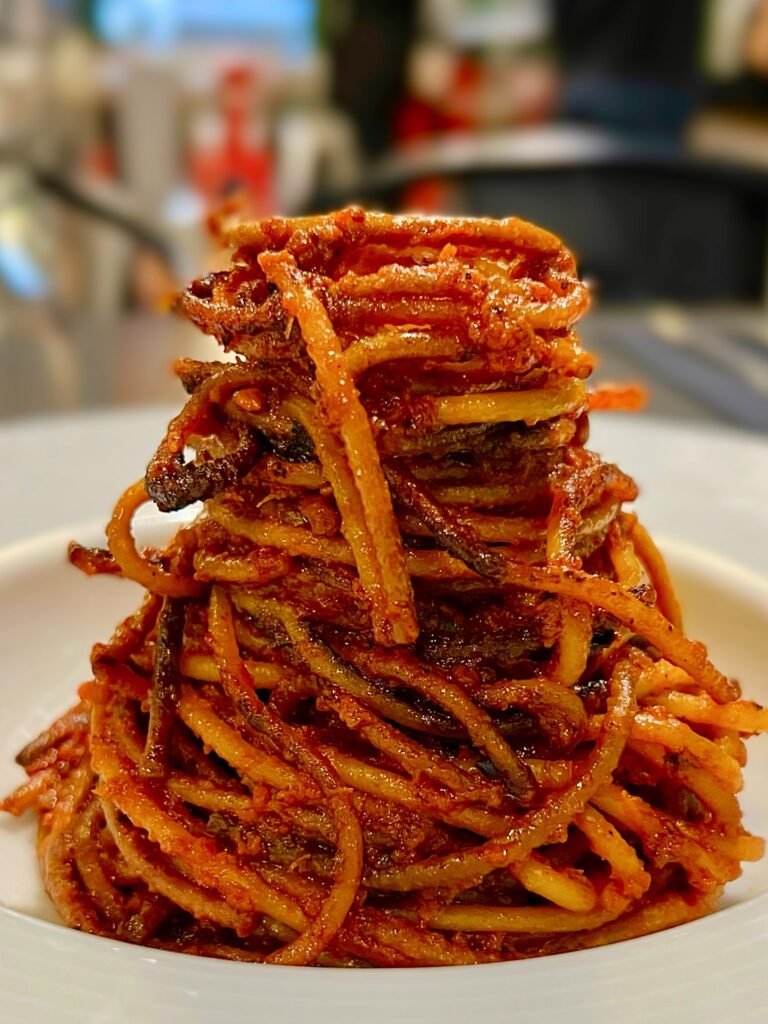
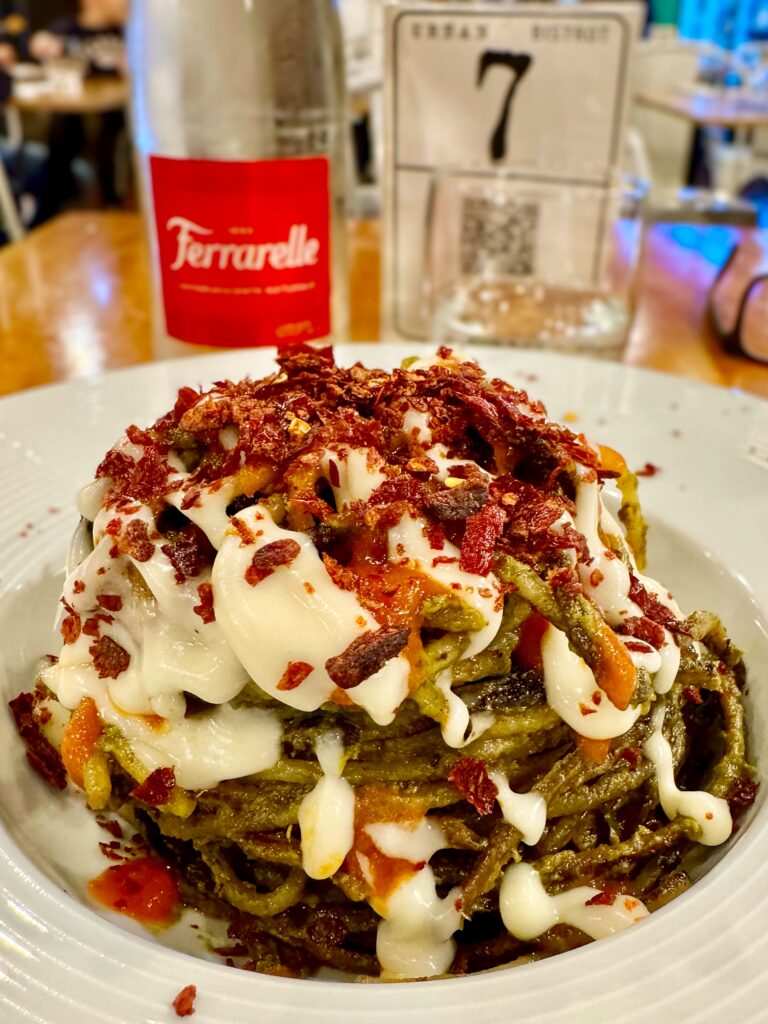
If you visit, stick to what the Assassineria Urbana does best and order classic spaghetti all’assassina.
Via Nicolai 10, tel 080 645 8469 | website.
Weilà
Try their interpretation of classic Barese dish done Puglian style with rapa, crumbled tarallo and burrata. Via Giovanni Amendola 145/A, tel 080 918 7350 | website.
Take me to the recipes.
The accademia are purists when it comes to cooking spaghetti all’assassina. They are strict in terms of ingredients and method. In our Puglia Kitchen we are a little more relaxed when it comes to ingredients. It’s the crunchy smokiness that’s essential to spaghetti all’assassina – and why we are more precious when it comes to method!
But let us be clear! In our Puglia Kitchen we have tried and tested various versions. These are our take-away points:
Second day spaghetti is best left for frittata.
Toasting the spaghetti adds flavour and texture. At home, without the pressures of service, there’s plenty of time to cook assassina according to the accademia recipe.
The pan
Traditionally, spaghetti all’assassina is cooked in a thin black iron pan called a sartàscene, placed over a very high flame. However, this pan is no longer standard in most kitchens (and difficult to find). Many chefs now use a thicker iron lionese pan. In our Puglia Kitchen we use a large non-stick aluminium pan.
The pasta
Recipes often advise against using bronze cut spaghetti because it becomes too starchy for this recipe. We find any difference negligible. Use a good quality spaghetti.
The chilli heat
Spaghetti all’assassina isn’t as fiery as the name might suggest. Traditional Puglia cuisine uses chilli for flavour rather than intense spice. While locals might find one or two red chillies spicy, visitors used to hotter cuisines may find it relatively mild.
For more kick, try using at least three dried chillies, or add Calabrian ’nduja for a deeper heat—just note it’s not vegetarian. Fresh chillies work too, especially if you’ve got a homegrown supply.
To risottatura, or not to risottatura
We always start by toasting and blistering our spaghetti in the oil, garlic and chilli (with just a little passata added). We find this adds a nuttier flavour and a unique texture to the pasta, an “ultra” al dente. If you want to pre-cook your spaghetti first, as many commercial kitchens do, then we recommend it goes into passata in the pan and then cook it risottatura style. We find it easier to get the crisp burnt edges that way.
Spaghetti all’assassina v1.0
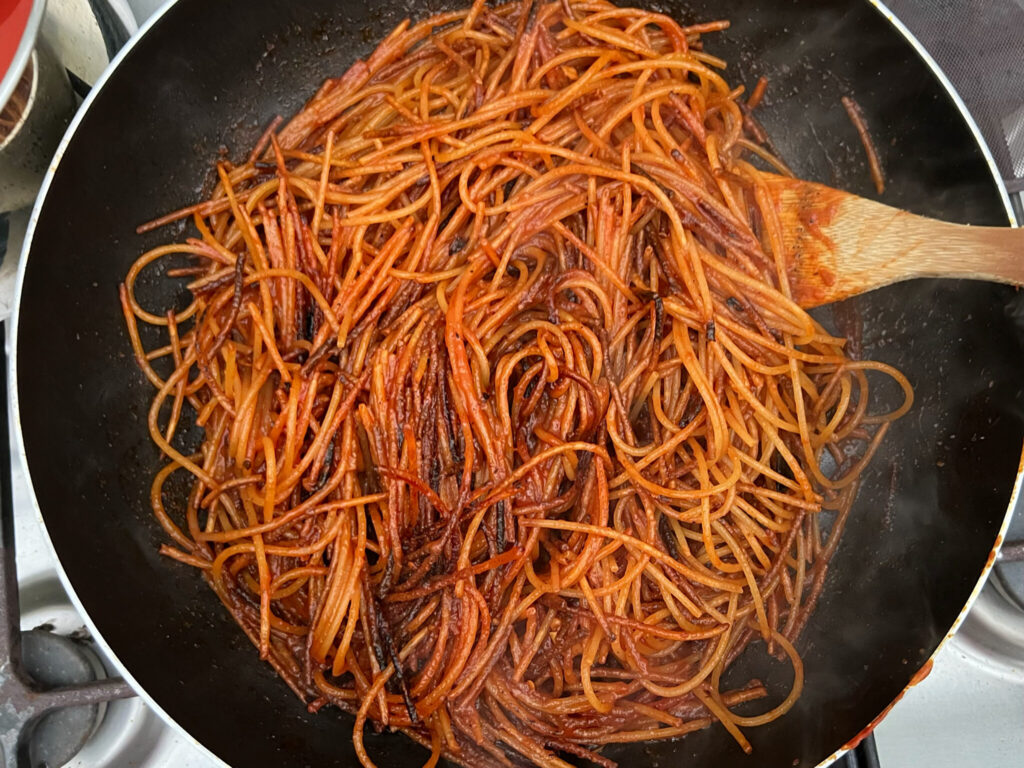
The version of the Accademia dell’Assassina of Bari. Serves 4.
For this dish you will need:
- 400 g of spaghetti
- 150 g of tomato passata
- a tube of tomato concentrate
- extra virgin olive oil
- garlic
- chilli pepper
- salt
- sugar
- black iron pan from Traversa Fratelli, Bari Vecchia
- wooden spatula of non-specific origin
In a separate pan prepare and bring to a boil a broth. Made with plenty of water, the tomato concentrate and salt. It must be bright red and tasty.
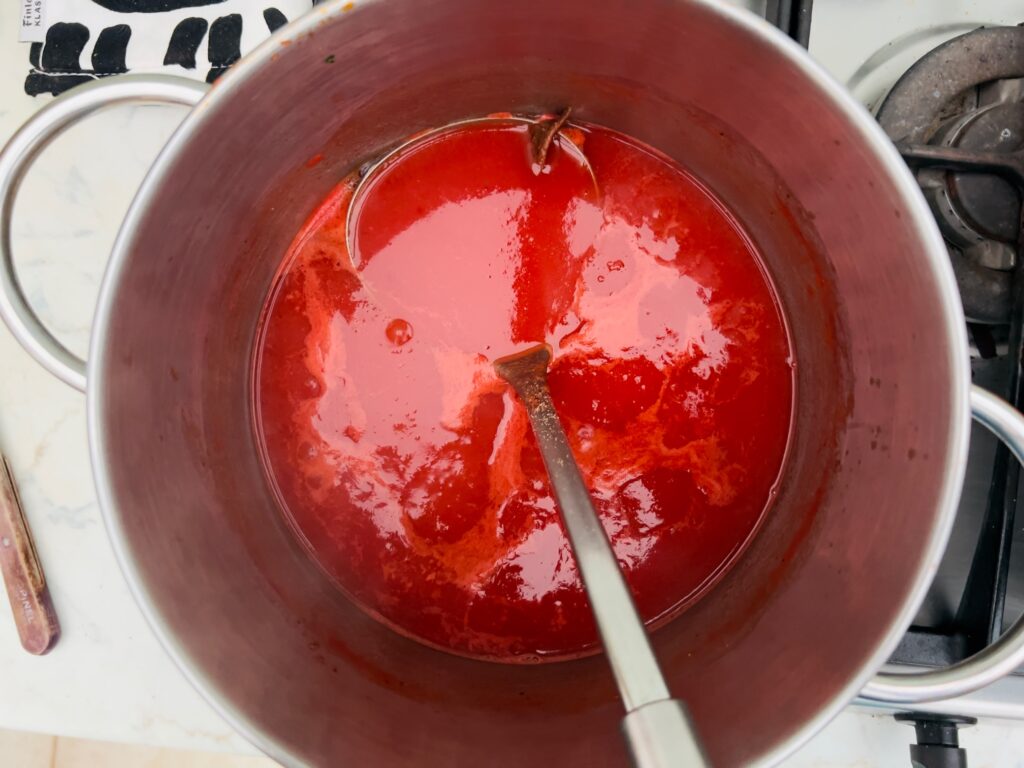
In your seasoned black iron pan, pour approximately 150 g of oil, three cloves of garlic without the green centre and an abundance of chilli (two whole and a little chopped). With a lively flame, brown the garlic, then pour in the tomato passata.
The pan will spit and splutter, but the Assassin is well worth the cause. If necessary, add a pinch of sugar to correct the acidity of the tomato. Spread the passata over the entire base of the pan. For this a wooden spoon can be used. Then release the raw spaghetti directly into the pan.
With skill and mastery, you have to start turning the spaghetti carefully, letting them start to stick a little to the bottom of the pan, the iron ones you can only find at Traversa Brothers in Barivecchia (unfortunately “temporarily” closed due to indisposition), lifting up those that start sticking. Use a wooden spatula it serves the purpose better than the spoon.
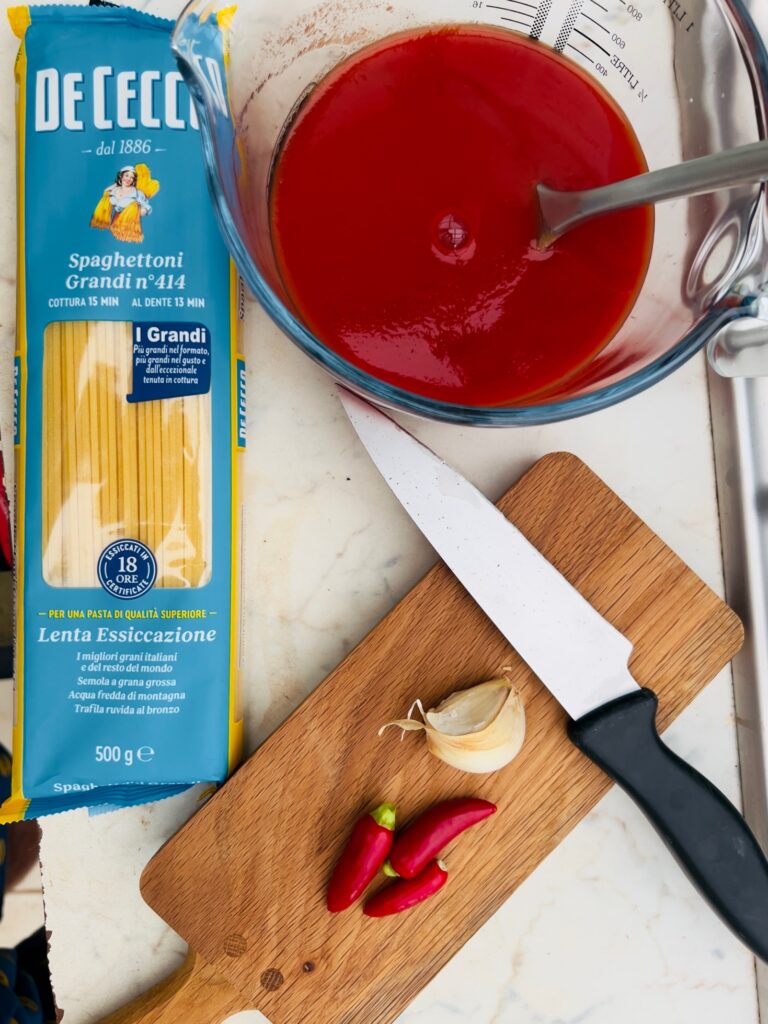
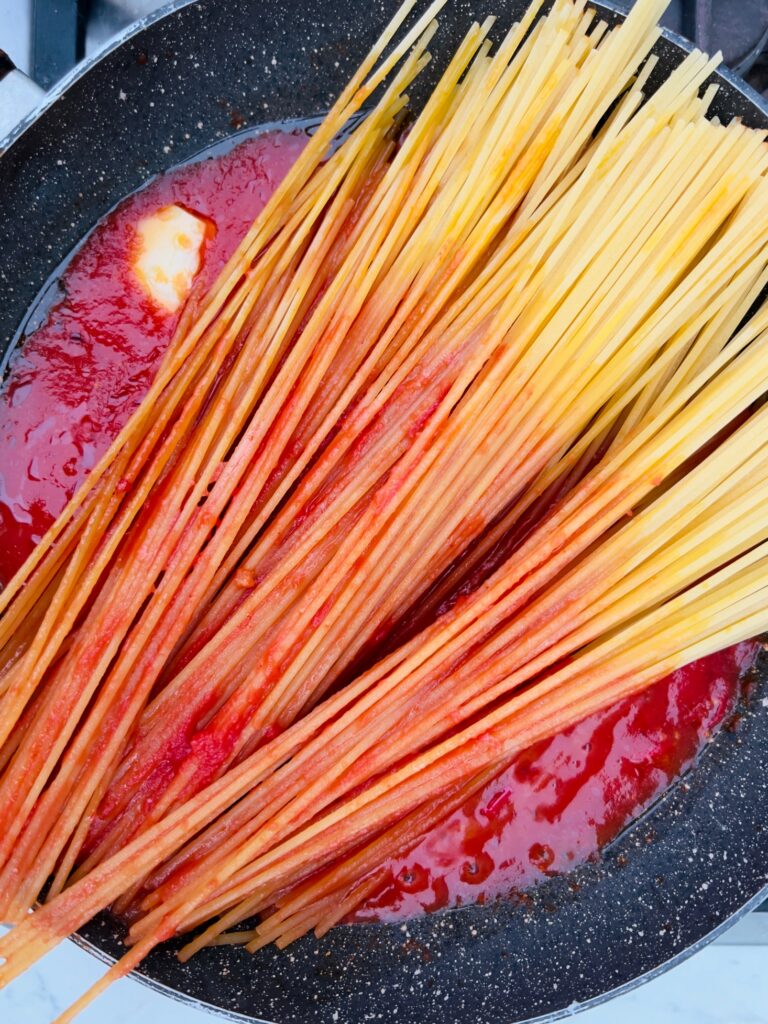
Pour a medium-sized ladle of broth over the spaghetti and continue to stir. As soon as the broth begins to simmer, let the spaghetti absorb it, without turning the spaghetti. Listen carefully to the start of cooking. When you hear “sizzling” again, with the wooden spatula, lift the spaghetti that has stuck to it and, as before, turn it over bringing those starting to burn to the top and letting those less cooked find the bottom.
Pour in another ladleful of broth and continue like this, as if you were preparing a risotto, but without stirring constantly, one ladle after the other with the necessary breaks to listen to the sizzling of the oil. Gradually the spaghetti will begin to bend, to assume sinuous shapes in the pan, to fall in on itself. Have no pity. Continue to treat it harshly and after 8 – 9 minutes of punishment, when the balance of colors turns towards red-brown with burnt bits from the spaghetti that does not want to detach itself from the base of the pan.
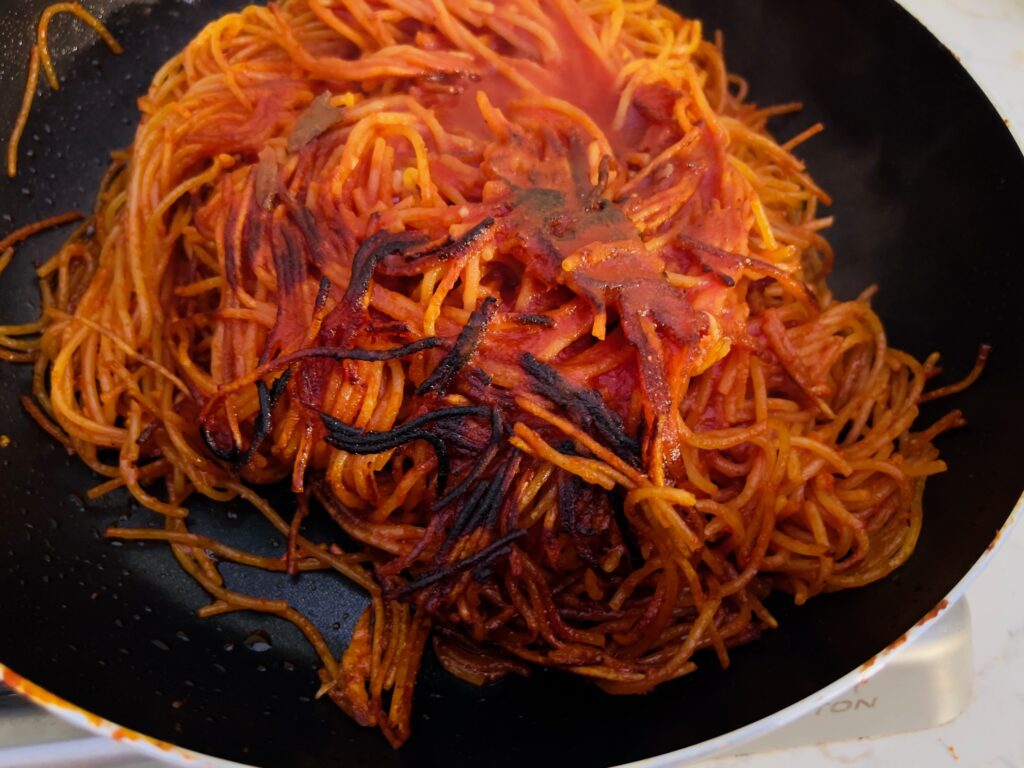
Then finally taste and evaluate the degree of cooking. Of course, by cooking directly in a pan it will not be possible to obtain the same degree of consistency as a spaghetti cooked in water and salt. As it should be. The spaghetti must be more calloused, more inviting under the teeth. Be careful though, only the scorched spaghetti should “crack”. The degree of cooking and burning is for you to decide. You must have an eye and taste. When it is decided, in your opinion, the Assassina is ready, serve immediately, taking the pan to the table and dishing up from there.
This is the more or less the version of spaghetti all’assassina that we make at home, albeit with slightly different measurements. The photos used are in this section are our efforts killing the spaghetti at home.
Spaghetti all’assassina v1.5
This version of spaghetti all’assassina involves boiling the spaghetti briefly for a few minutes before killing it in the frying pan. Serves 4.
For this dish you will need:
- 400 g of spaghetti
- 250 g of already cooked and reduced tomato sauce (better if ragù alla barese)
- a little extra virgin olive oil
- 1 clove of garlic
- chilli pepper to personal taste (the dish is still spicy)
Drop the desired quantity of spaghetti into plenty of lightly salted water, and wait a few minutes for them to soften, then drain them well with tongs, keeping the cooking water aside while still warm; dress them immediately with a ladle of sauce and mix them.
In the meantime, in a large iron pan you will have already heated the oil with the garlic and the chopped chilli pepper over a high flame. Once browned, remove the garlic clove and put the spaghetti, already partially seasoned with the sauce, in the pan.
Spread the spaghetti to the edges using a wooden spatula, leaving a void in the center. Now pour a ladle of sauce in the void, diluting it immediately with a little water from cooking the pasta. Without stirring, but with a circular movement from the edges of the pan, push the pasta towards the centre.
Open out the spaghetti to make a well once again in the center, add the sauce and quickly repeat the same operation. The pasta should be touched as little as possible because it must absorb the sauce and cook over high heat. It should not be skipped or stirred, but almost caressed in a circular direction with the wooden spatula. When, to the eye, it will seem almost cooked – if you are not sure, taste it – add a ladle of undiluted sauce, then turn up the flame to the maximum letting it toast for a few minutes more without stirring further. Bring to the table and serve immediately.
Spaghetti all’assassina v2.0
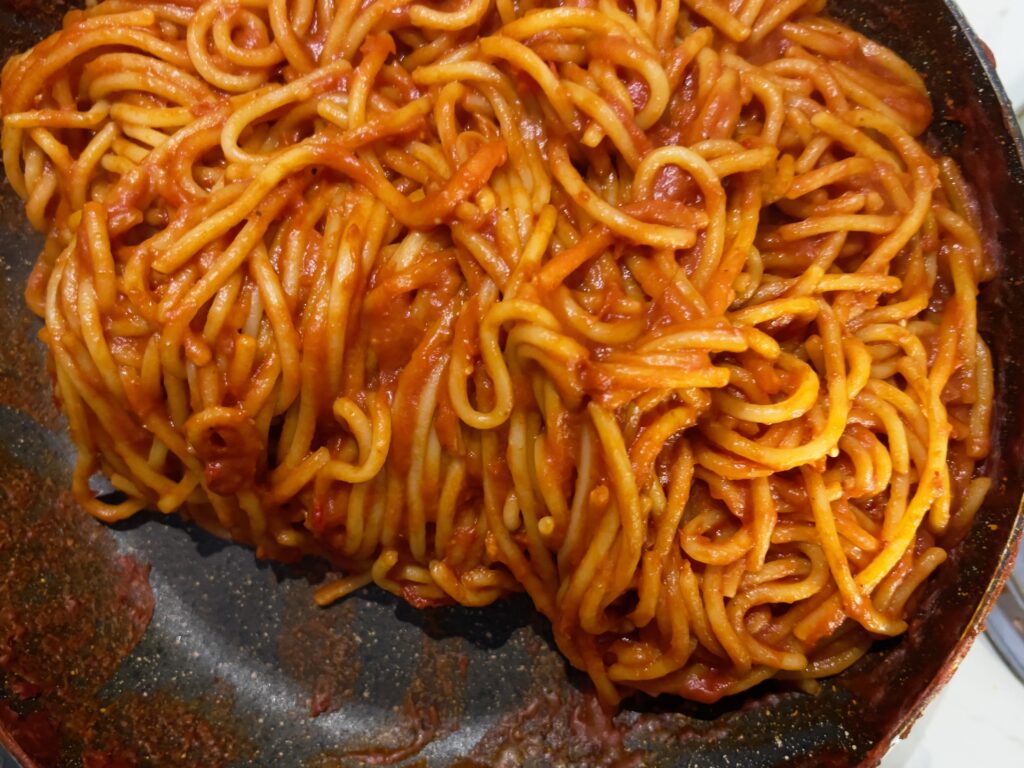
Known as ‘o ragù de la dì appriss’ – ragù of the day after. We tried it, but Riccardo dismissed it. Despite forming a crust, rather like an omelette, the pasta lacked the distinctive crispness of v1.0.
For this recipe you need leftover cooked spaghetti with tomato sauce or meat sauce from the day before, abundant chilli pepper, extra virgin olive oil. Warm up the oil in an iron pan, release the spaghetti, add the chilli pepper and brown it until a dark crust forms.
With one caveat: this dish should be eaten piping hot to appreciate the crunchiness of the pasta.
Spaghetti all’assassina vLolitaLobosco
This is Lolita Lobosco’s version from the novel ‘Spaghetti all’Assassina‘ by Gabriella Genisi, using red wine from Puglia.
For this dish you will need:
- 500 g of spaghetti
- 10 cherry tomatoes
- a couple of chillies
- 250 ml of full-bodied red wine, Primitivo di Mandria preferably
- garlic
- oil q.b.
In a pan, sauté the garlic with the oil, the chillies and the cherry tomatoes cut into quarters. Gradually add the wine and let it evaporate. Boil the spaghetti al dente, drain it reserving a ladle of water. Add the al dente spaghetti to the sauce and sauté them together, adding the pasta liquor as needed.
Spaghetti all’assassina vCarofiglio
This is the preferred version of Mediterranean noir author Gianrico Carofiglio, included in the novel ‘La casa nel bosco’ written with his brother.
“It is a classic recipe from Bari which takes its cue from the popular tradition of using leftover food. The question of food is delicate in novels, because, like certain spices, you need to use an extremely small quantity, otherwise they make the dish cloying. I stop reading novels that talk too much about food. It is a matter of portioning it carefully, because there is a risk of ruining the dish. I like to think that, like all the digressions contained in the novel, they have a metaphorical value, a narrative function”.
For this dish you will need:
- 500 g of spaghetti
- 1/2 l of tomato sauce
- 4 tablespoons of extra virgin olive oil
- 1 clove of garlic
- salt
- chilli
While you put the water to boil, prepare a tomato sauce with the oil, the garlic, a pinch of salt and plenty of chilli.
Drain the spaghetti when they are very al dente, I would say a little undercooked.
Pour the sauce into a very large non-stick pan (which is the secret to the success of the recipe); the ideal would even be a wok.
In the pan, or in the wok, pour the spaghetti.
Put the pan on a stove with a rather high flame and with a wooden ladle press the spaghetti against the bottom and sides of the pan, like an omelette, for about ten minutes or in any case until the pasta comes into contact with the pan has not hardened and scorched.
At this point, again as if you were making an omelette, turn the spaghetti upside down and repeat the procedure.
The idea is that, in the end, a burnt crust is produced, while the inside remains soft, but always al dente. When serving, pour a drizzle of raw oil over each portion.
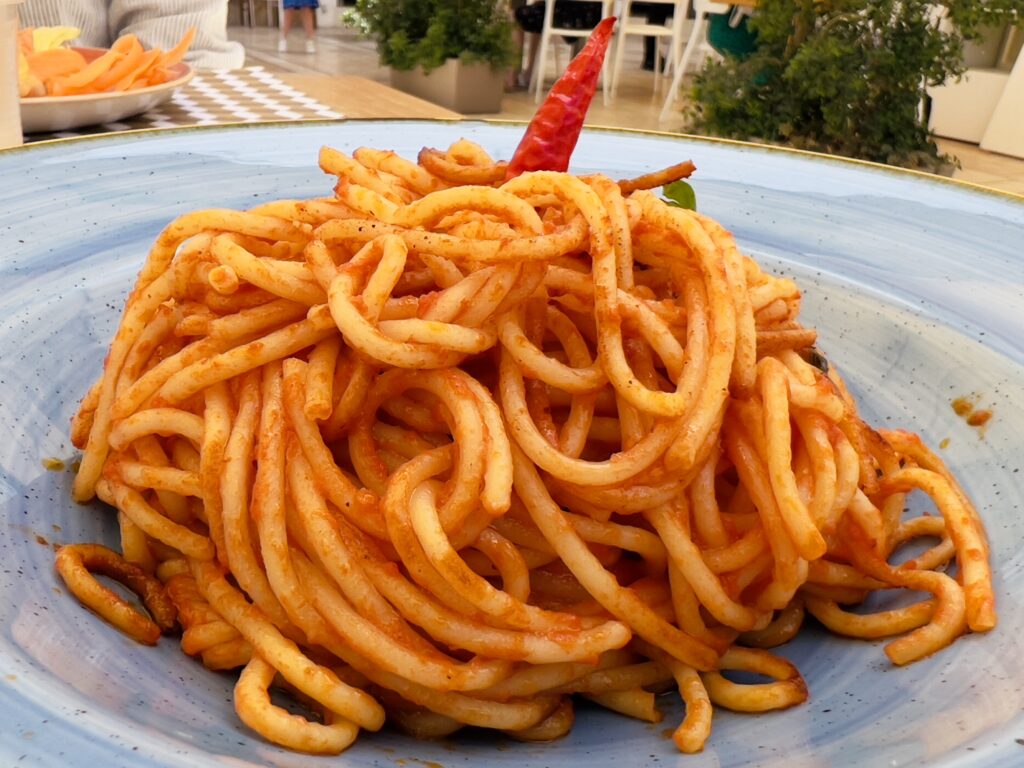
Spaghetti all’assassina vPuglia Guys
The Accademia dell’Assassina of Bari are inflexible when it comes to both method and ingredients. We agree that the method is essential to the dish. Assassina needs to cooked risottata. The spaghetti needs to burn and scream. But like the International Assassina Academy (worldwide spaghetti all’assassina ambassadors established to promote and curate Bari’s signature dish as its popularity spreads around the world) we are more flexible when it comes to the ingredients.
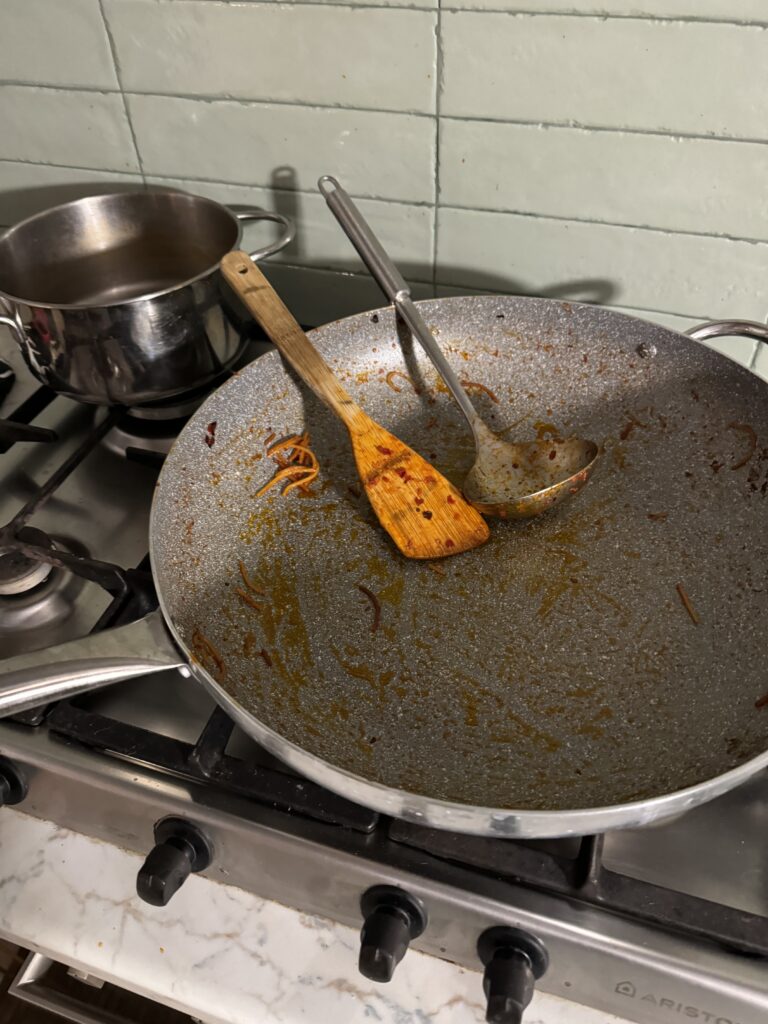
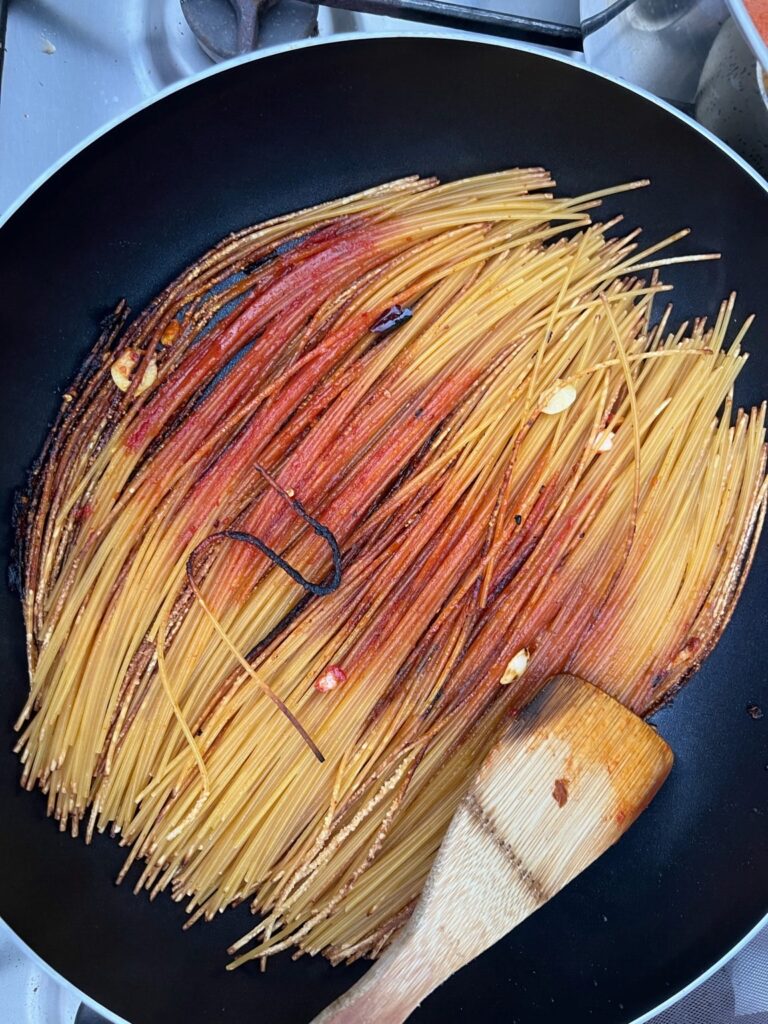
The ingredients
We use a full 500g packet of spaghetti—just enough for four, or a generous portion for two with leftovers (which make a brilliant beach-ready frittata!).
Instead of chopping the garlic, we crush it. This helps prevent bitterness if it catches in the pan, and it gently melts into the sauce as it cooks.
Don’t worry about using all the tomato broth—just add it gradually, ladle by ladle, as the pasta absorbs it. The same goes for olive oil—adjust as needed while you cook. We recommend using at least 3 dried red chillies, finely chopped or ground. But more recently we have taken to using Calabrian ‘nduja for the fire. ‘Nduja is one of our essential store cupboard ingredients. Made using lard, finely chopped pancetta and guanciale – a cured meat made from pork cheeks – dried and fresh herbs and of course, Calabrian red chillies. It does mean this version of the recipe will no longer be suitable for vegetarians.
You can use chopped fresh chillies if you have them. We do when we have a glut of them in our Puglia Kitchen garden.
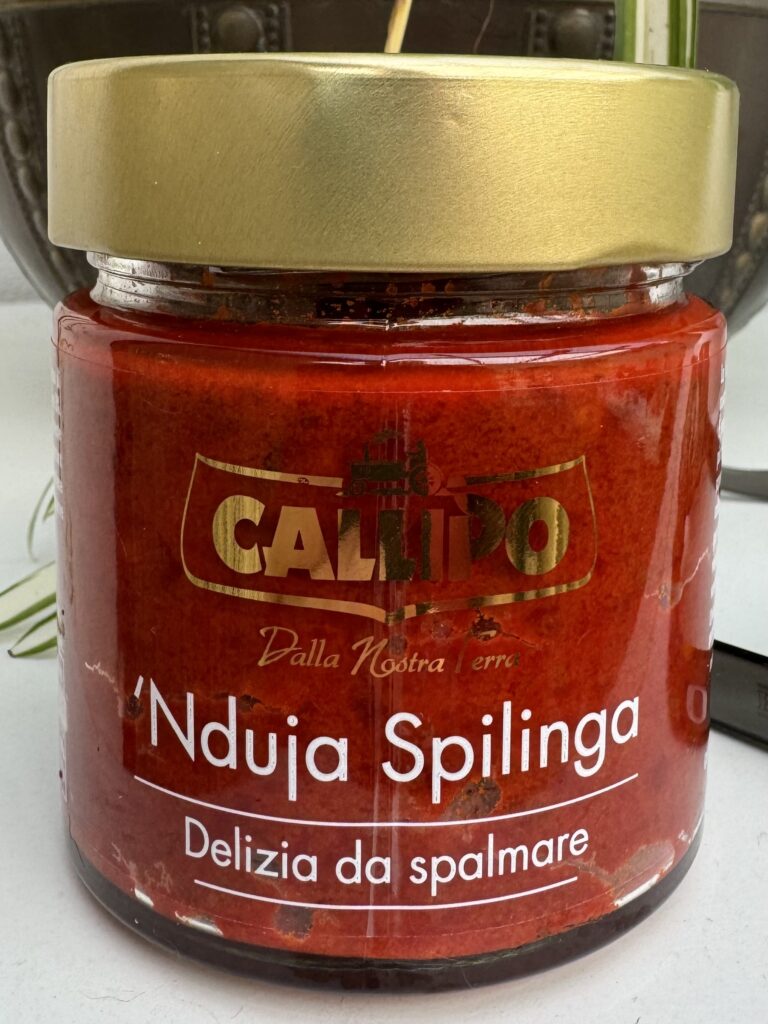
The method
Unlike many dishes that visitors eat on holiday in Italy and try to replicate at home with varying degrees of success, assassina doesn’t rely on fresh, locally sourced seasonal ingredients that we have on our doorstep. It’s all about the method.
Spaghetti all’assassina is also called “burnt spaghetti” – spaghetti brucati. But care needs to be taken that the dish acquires a smoky intensity rather than bitter burn. We consider that it is essential that the spaghetti calluses and blisters first before adding the passata or broth. So take a few minutes before adding either to char and blister the spaghetti in the oil, chilli and garlic (but we do add a little tomato concentrate at this stage for a deeper caramelised taste).
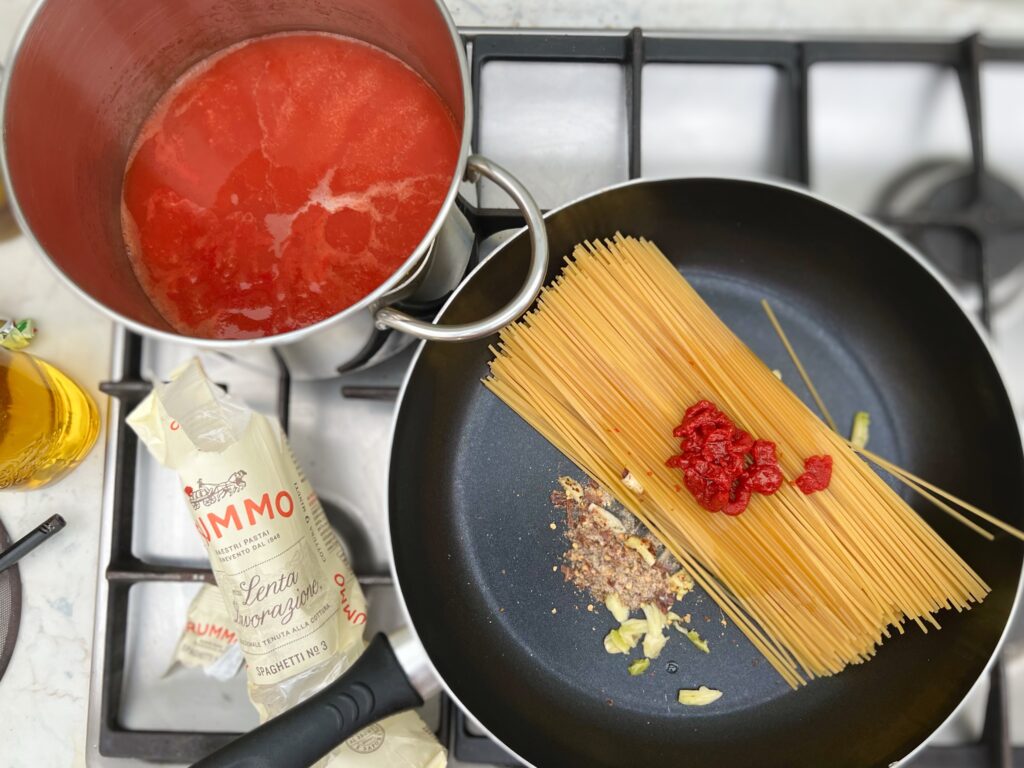
Pronti, partenza, cucina!
For this dish you will need:
- 500 g of spaghetti
- 150 g of tomato passata
- a tube of tomato concentrate
- extra virgin olive oil
- garlic (3 large cloves, crushed)
- chilli pepper (3 dried, ground) or 15 g of ‘Nduja
- salt
- sugar (optional)
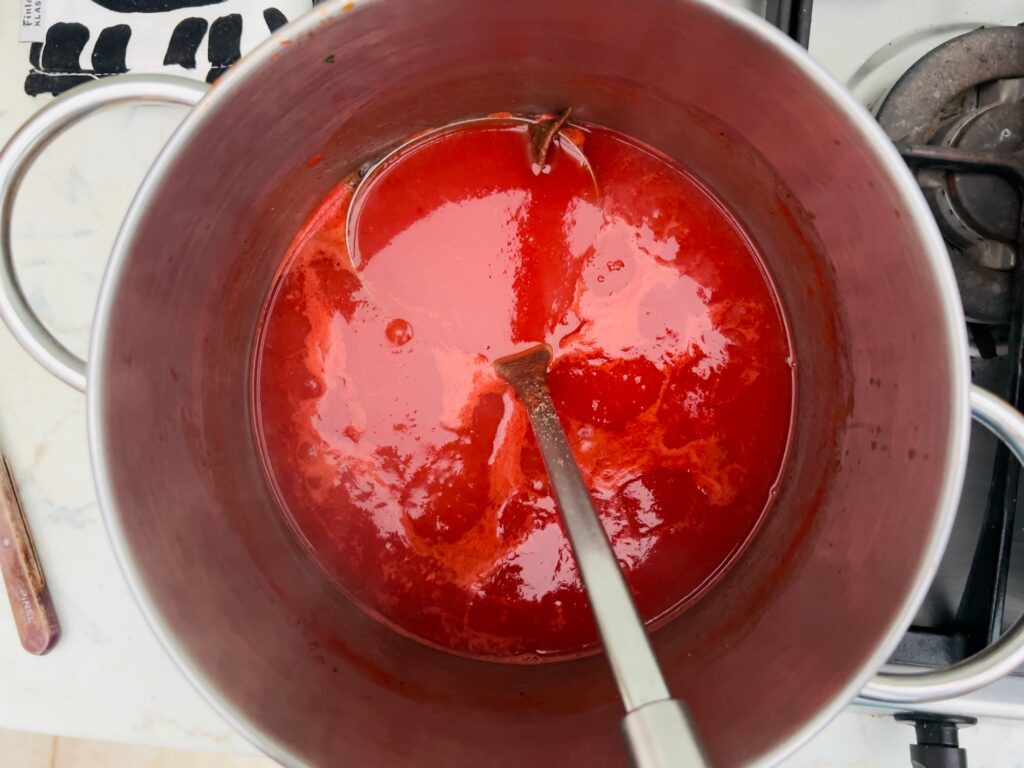
1. Prepare a broth made with water (1 litre) and the tomato concentrate (reserving a couple of squeezes from the tube of concentrate for the pan). Season to taste – we don’t add salt to the spaghetti, so be sure to season the tomato broth well – and bring to a boil. The sauce “must be bright red and tasty, but still a broth.”
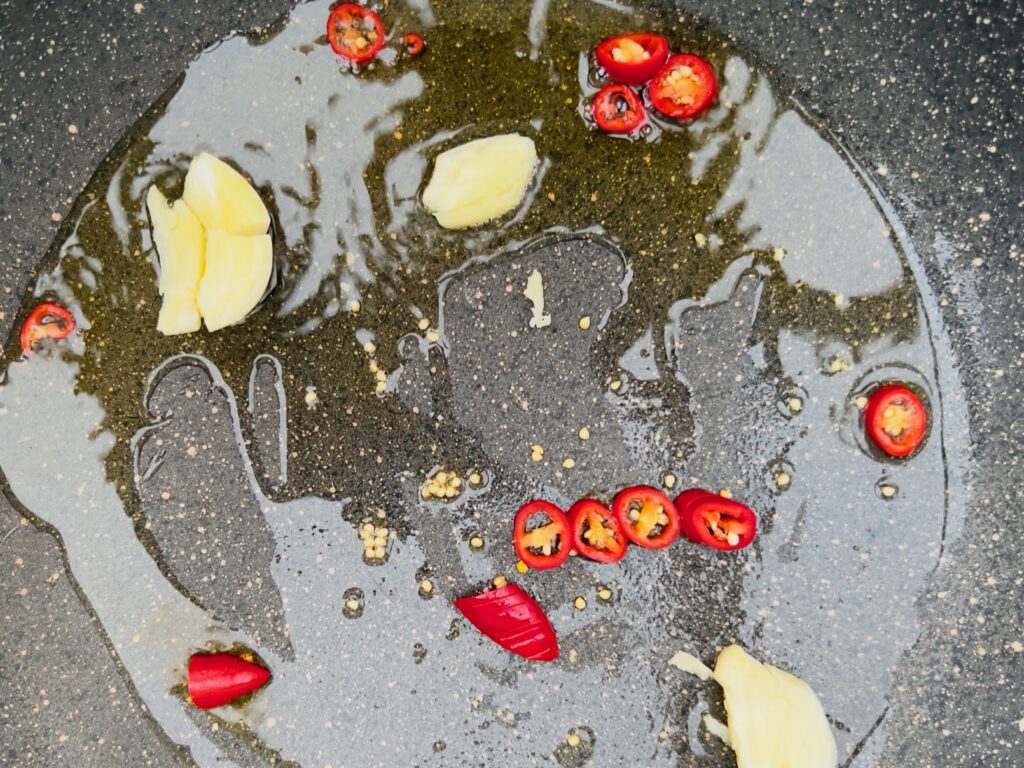
2. Pour a generous glug of extra virgin olive oil into the pan. Add 3 cloves of garlic slightly flattened and crushed using the flat of a kitchen knife, and the dried red pepper flakes (we used fresh chilli from our garden in this photo simply to use them up). If you are using ‘Nduja instead, add this now. Heat over a high heat until the garlic sizzles, but don’t let it burn and get bitter.

3. Drop the dry spaghetti in the pan and spread into an even layer. Squeeze the remaining tomato concentrate on top of the spaghetti.The first step is to step back. Let the pasta callus, blister and blacken slightly before flipping it over to do the same on the other side. Use your ears and nose. Listen for the sizzle and smell the smokiness.
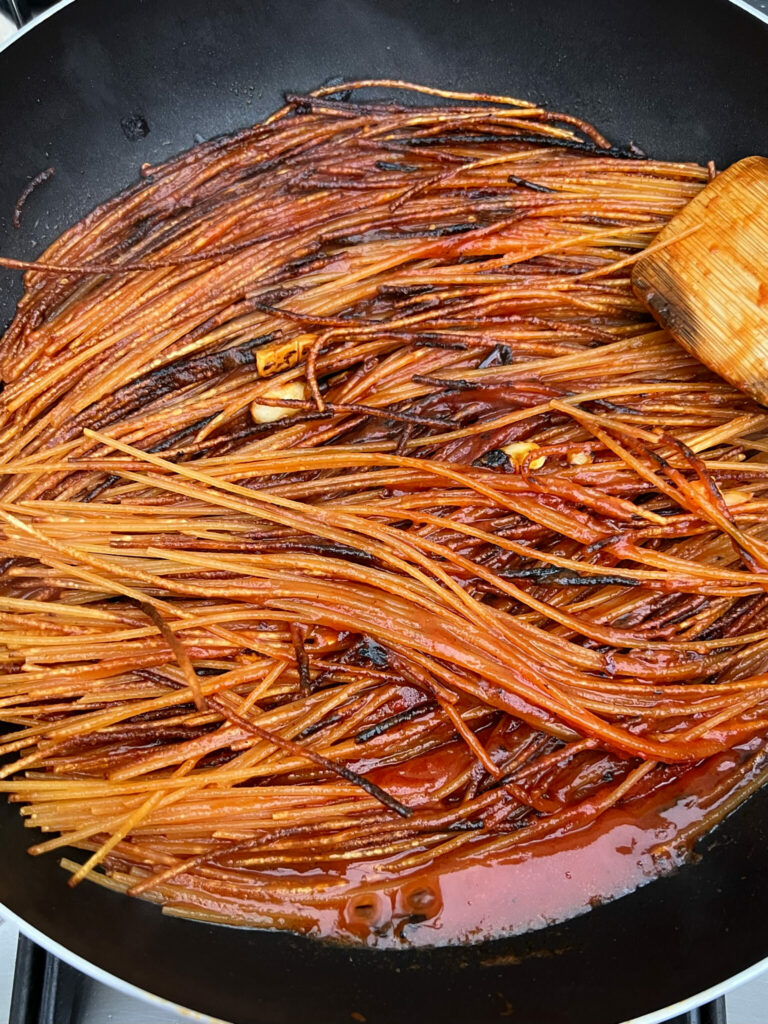
4. When the pasta has blistered and slightly burned on both sides, pour the passata into the pan. Add a little sugar if you are worried about the dish turning bitter. The passata will sizzle and start to simmer. Let it reduce without turning the spaghetti and listen carefully for the boiling point. When you hear it sizzle again (the noise changes sharply) remain patient and wait for sauce to start to catch on the base of the pan (this will take 30 seconds to 1 one minute). When it does, leave it for another 30 seconds or a minute. Then flip the spaghetti over, and leave it to catch on the base of the pan again (another minute or so).
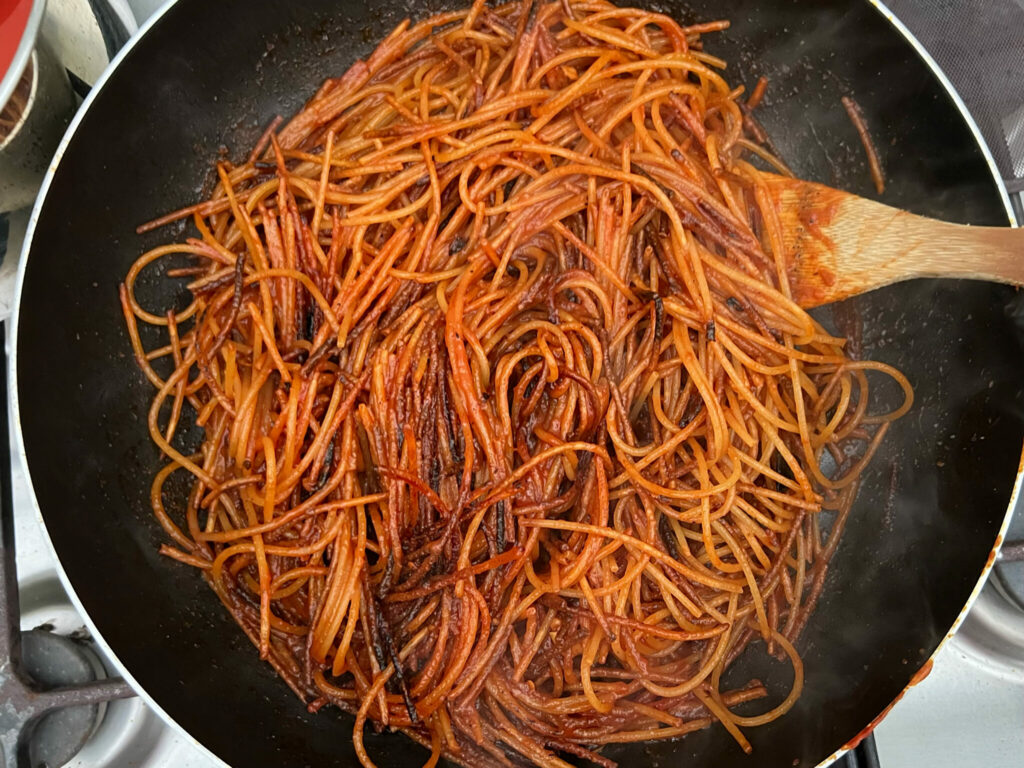
5. At this point the pasta can be stirred slightly. It should remain quite stiff. Pour 2 medium-sized ladles of the tomato broth over the pasta. Once again, stand back. Let it reduce without turning the spaghetti and listen carefully for the boiling point. When you hear it sizzle again (the noise changes sharply) remain patient and wait for the burning process to continue (this will take 30 seconds to 1 one minute). Repeat, stirring to remove the burnt spaghetti from the bottom of the pan while adding more tomato broth. Each addition must correspond to the time needed for it to sizzle and then repeat by soaking the pasta with the broth. The stiff spaghetti will soon start to soften. The spaghetti must “be killed”, letting it catch and burn.
The pasta shouldn’t swell as it does when boiled. But it should be cooked through until the spaghetti is al dente, which usually takes us some 15 minutes from the first ladles of the tomato broth. You may need to add some more olive oil to the spaghetti to help it on its way. Clumps of burned pasta can be separated by stirring and turning the pasta.
Serve immediately, while hot and fiery. Drizzle with some olive oil for extra pepperiness.
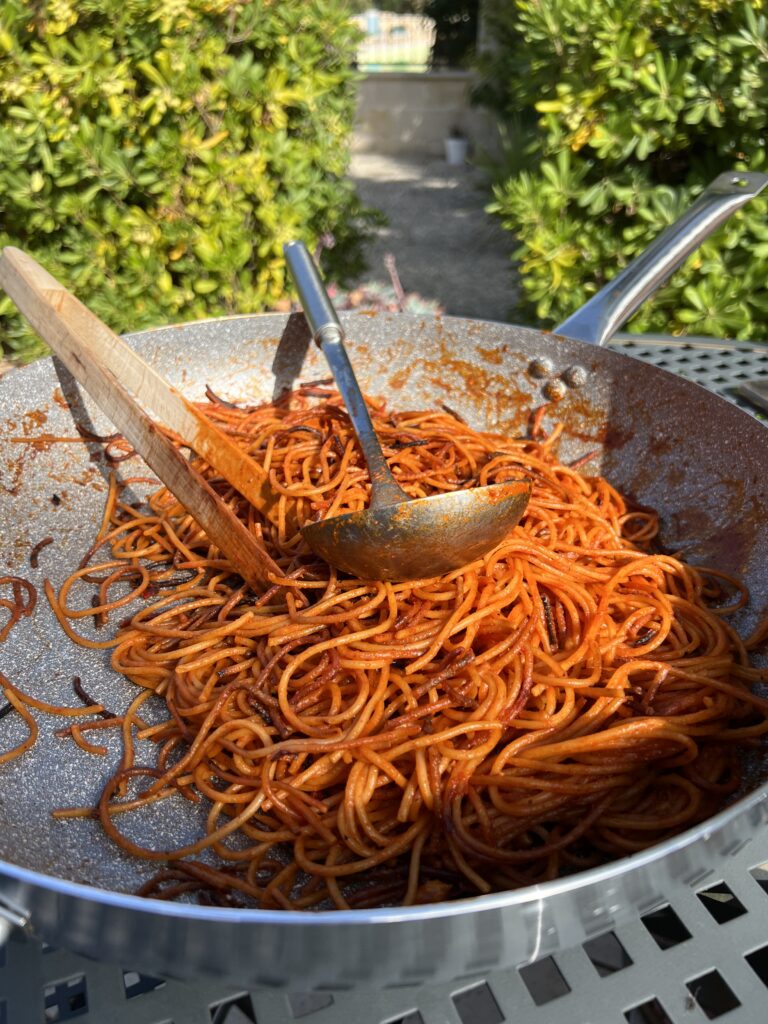
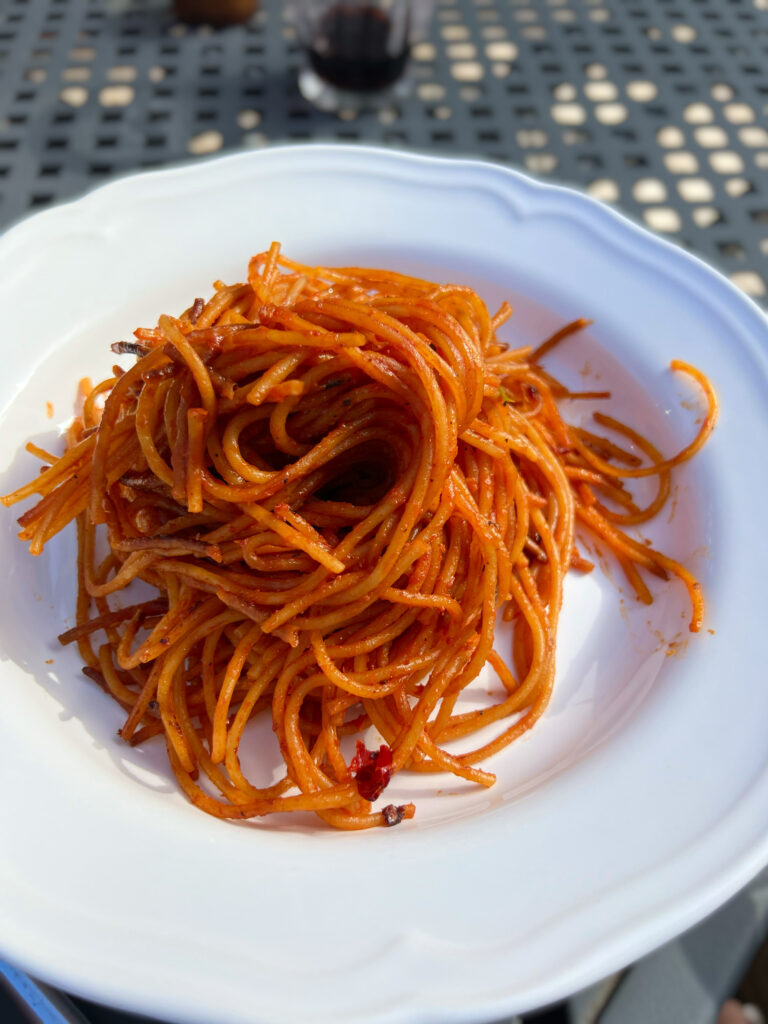
A word about garnishes
In Bari Vecchia, assassina is often found with a garnish of stracciatella (a creamy shredded mozzarella). Many think this is to soften the fiery heat of the dish. But as we have noted, you will rarely find an assassina served in restaurants that offers more heat than a gentle tang of chilli. Rather it is borne out of an increasing trend to garnish all dishes with stracciatella!
However, the creaminess of the stracciatella suits this drier pasta dish (assassina shouldn’t come in a sauce as the spaghetti absorbs it all). But best of all, use smoked burrata, complimenting the smokiness of this killer dish.


Puglia by food
#WeAreInPuglia. Other regional dishes are available. #EatPuglia and enjoy Puglia’s best dishes, streetfood, and regional produce. Buon appetito.
Bari Guide
You won’t understand the people of Bari, its seasonality or its soul, if you don’t wander the streets, the restaurants, markets, bars and cafes, picking up a local habit here and there. When you do you will discover a city that is vibrant and amazing.
Follow us on Instagram for frequent video stories, reels, photos, ideas and other information to inspire your stay in Puglia.

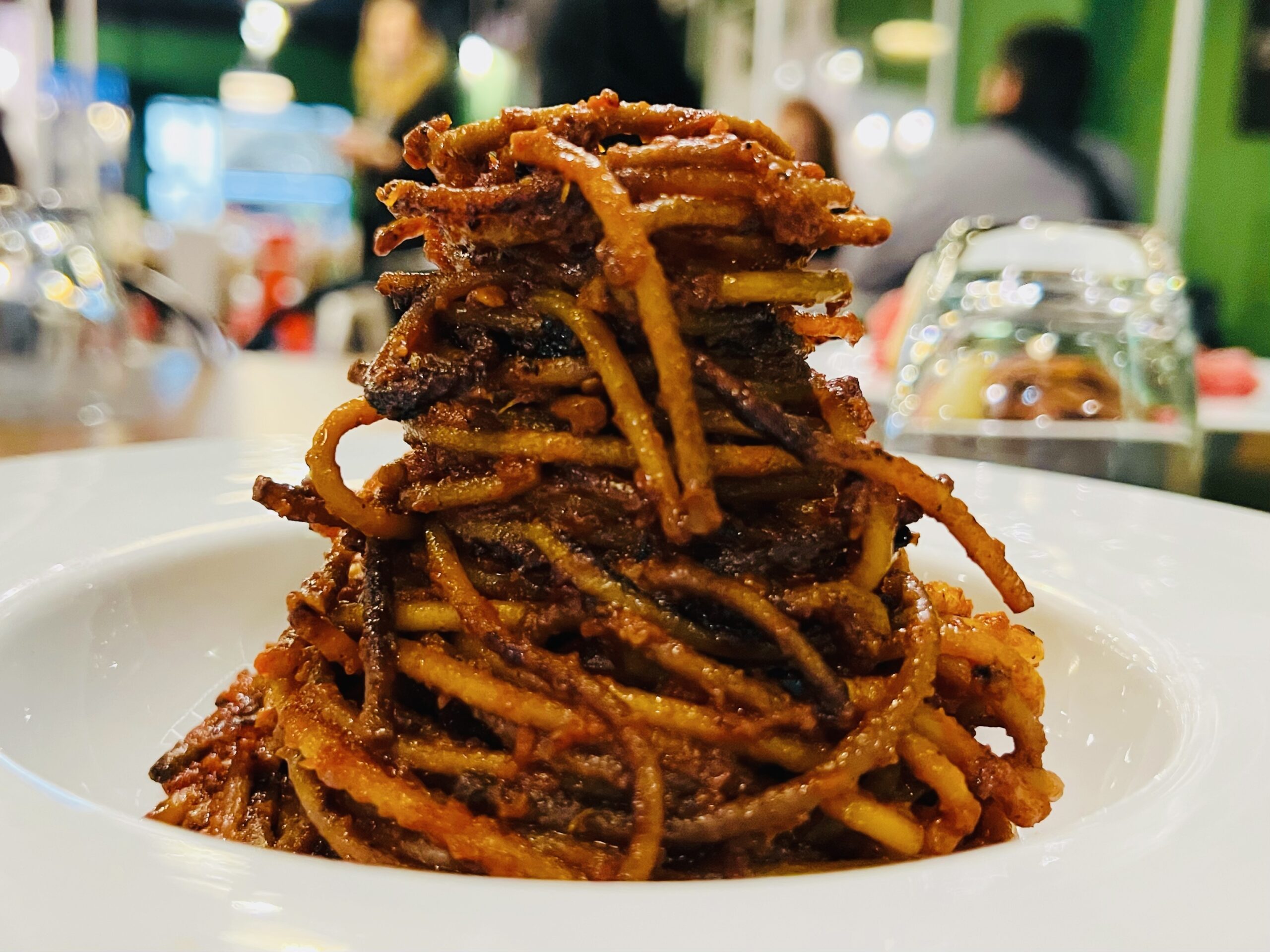
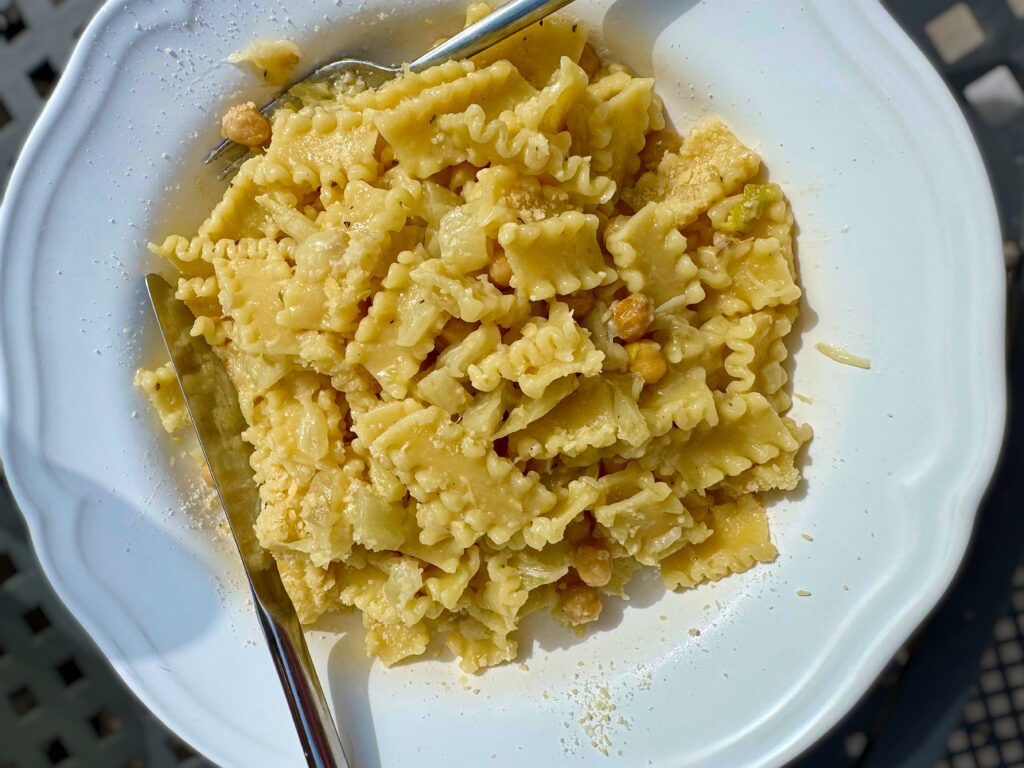
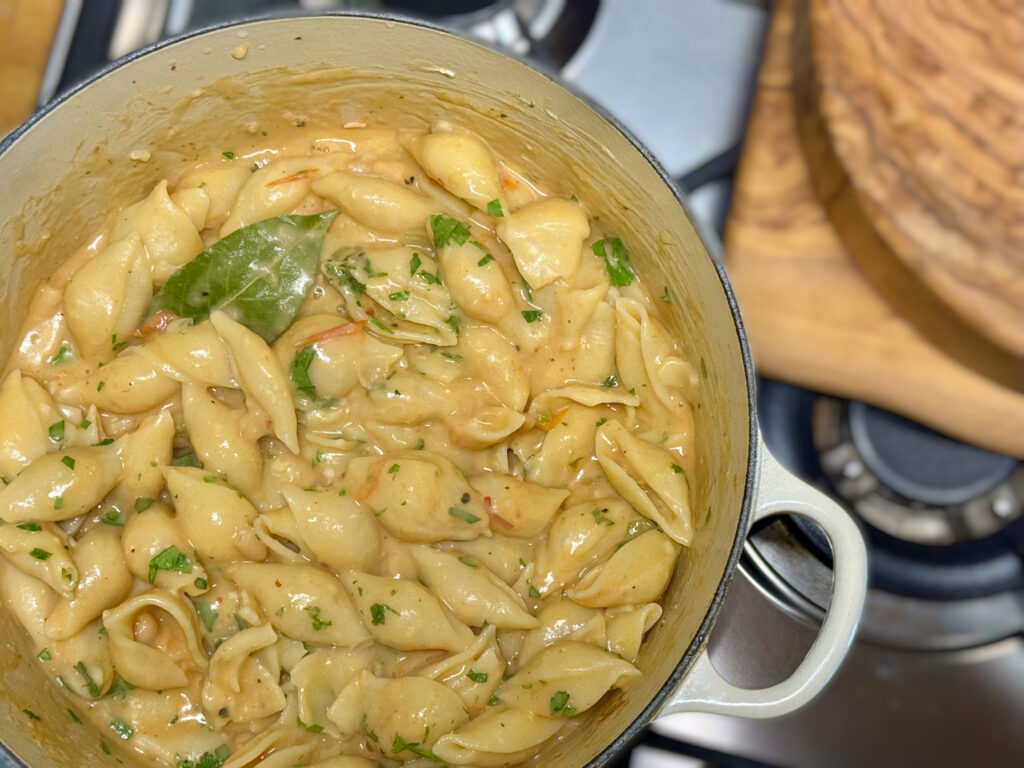
https://www.oraviaggiando.it/blog/spaghetti-allassassina-la-vera-storia-la-ricetta-le-testimonianze-e-i-falsi-miti/
https://pugliosita.it/2023/11/07/spaghetti-allassassina-la-vera-ricetta-descritta-dal-suo-inventore-enzo-francavilla/
https://www.barinedita.it/bari-report-notizie/n4863-bari-ecco-come-e-nata-la-moda-degli-spaghetti-all-assassina–il-piatto-dimenticato-per-trent-anni–
Not sure if you are still interested in this but it looks like “risottatura” is not the way to go with assassina, as the chef who created the recipe did not use that method. I’m not really sure where that comes from, the burnt spaghetti idea seems to be a false myth too.
Ahah! Hope you get the chance to eat it at Al Sorso Preferito where food historians and the official accademia attribute assassina’s origin. We are back again tomorrow.
LM.
Thank you so much for your brilliant website and recommendations. Using them for our travels through Puglia. Went to Bari today and Al Sorso Preferito for lunch, the assassina was delicious and a lovely restaurant. Bari itself was such an unexpectedly beautiful city, loved it.
Great! Al Sorso Preferito is great. It’s traditional but what we especially like is that is is the regular haunt of local residents, small groups of old men who lunch together and an era that’s almost gone when it comes to the service too! Grazie
Reading about this dish, I am seriously shook. The results you describe are almost identical to a dish my Syrian grandmother would make with raw spaghetti, tomato passata, lamb, onions… She would cook it in the oven and add the liquidy sauce as it cooked, stirring occasionally. I don’t know where she got the recipe from; she did not read English, but she could cook well.
How interesting! We must look into this – the precise origin of spaghetti all’assassina is debated. But another dish using a similar method, from another cuisine might not be such a coincidence! Thank you!
Any idea where one could find this dish served in the Nw York, New Jersey & Philly area of US?
Ahah! Unfortunately not. But we remember from reports in press here that the NY Times recently wrote about it. That might be a place to start? Good luck with the search.
https://www.nytimes.com/2023/10/06/dining/spaghetti-allassassina.html
Great job guys.
I have a fab picture of my besuited uncle in the fifties/sixties standing in front of Bari station fountain. He’s a bit scruffy but looks like James Dean, very cool.
Antdad (The Guardian, UK)
Top. If you ever find it send it to us if you like. We plan at some stage to do a “Puglia then and now” feature sometime. We still meet in front of the fountain there. An easy and obvious place to meet! Good luck with the assassina.